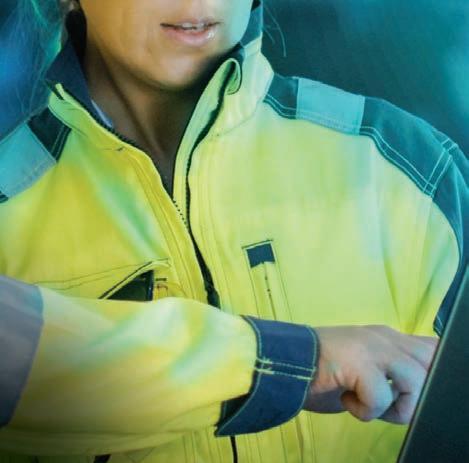

WRITING THE NEXT CHAPTER


A one-off paver purchase has transformed into a quarter of a century-long partnership

Secret in the soil
Brand new research is transforming what’s commonly found beneath our feet
Building blocks




A new delivery and storage method is ensuring bitumen supply for projects
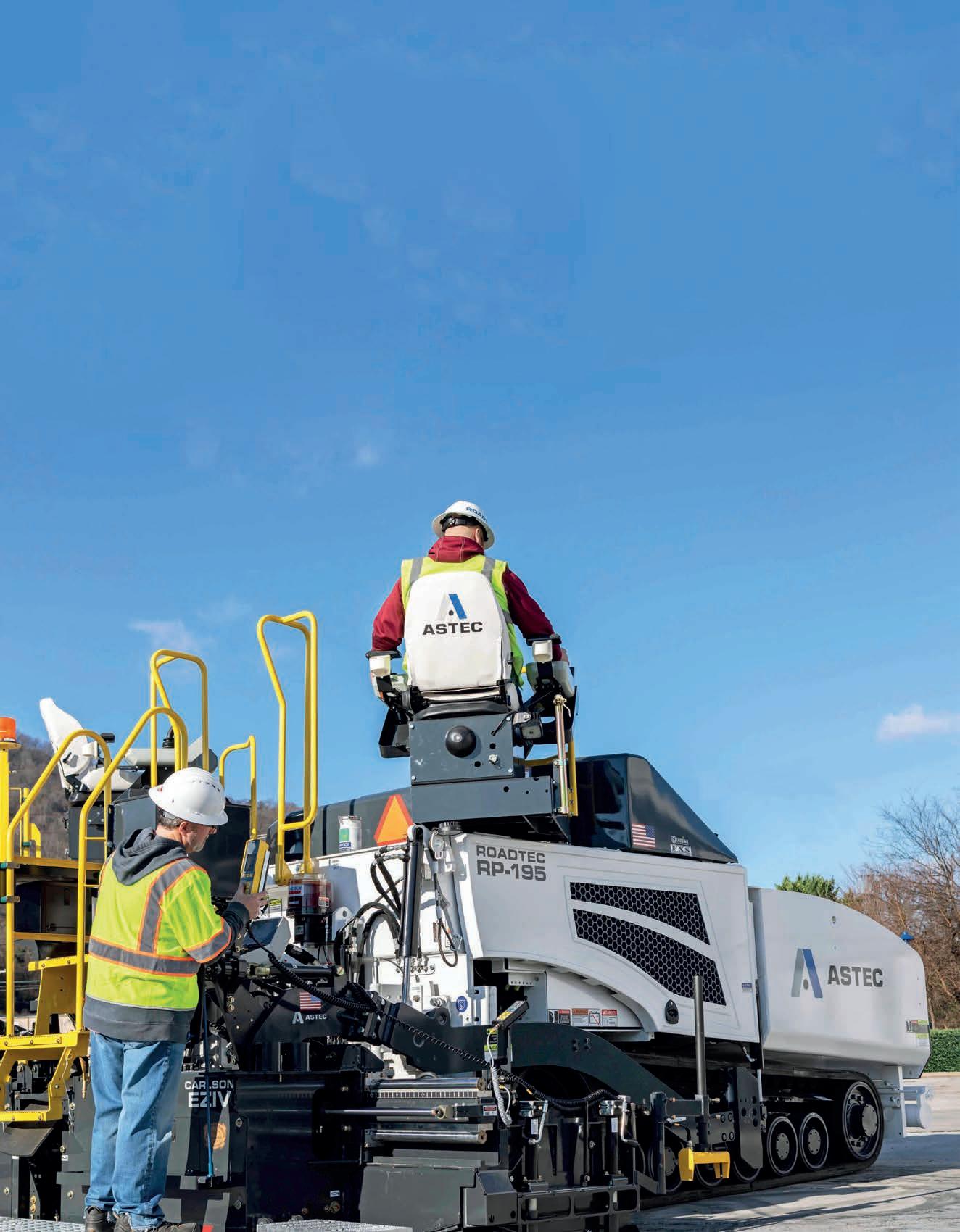




The Most Innovative Paver Technology!
VÖGELE SUPER 1700-3(i) / SUPER 1703-3(i)
VÖGELE SUPER 2000-3(i) / SUPER 2003-3(i)


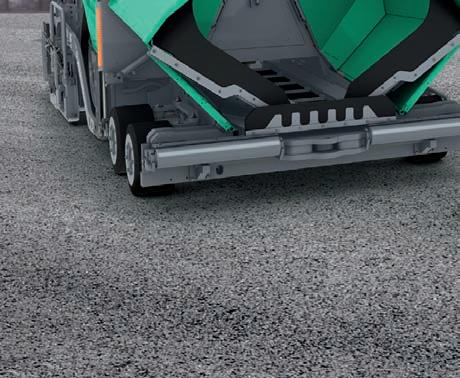









The number one paver manufacturer on the global market
Equipped with state-of-the-art Cummins engines available in either Tier 3 or Tier 4 Final / Euro Stage V emission standards, are the perfect choice for any application in the Universal (2.5m) and Highway (3.0m) paver classes. Thanks to the easy-tounderstand ErgoPlus 3 operating system which is common across all VÖGELE products both paver and screed operators can handle all VÖGELE pavers simply and safely. These machines are also available with vibrating screeds or high compaction tamping & vibrating screeds for those critical jobs. In combination with advanced optional features, such as VÖGELE EcoPlus, AutoSet Plus and Navitronic Plus 3D, these models are the stars of any road construction site.

COVER STORY
16 Writing the next chapter
State Asphalt Services has long placed its faith in Astec machinery for its equipment requirements.
ROADS REVIEW
20 This month, we asked the industry’s decision-makers, ‘What factors can help the industry build up more capability to deliver the current pipeline of construction work?’
INNOVATION
22 Transport’s tick of approval
NTRO Certification is expected to set a new standard for evaluations on the proficiency, sustainability and efficiency of products, processes and people.
TECHNOLOGY
25 Integral telematics
Geotab is shifting to an all-in-one telematics platform, providing fleet managers with the best foot forward when it comes to safety and reliability.
PROJECT REPORT
28 Everywhere you go
Works on the Hobart Airport have signified a shift in best practice when it comes to the delivery, storage and application of polymer-modified bitumen.
MACHINERY AND EQUIPMENT
32 The cherry on top
The expansion of the company’s hire division has signified a new direction for Matthews Brothers Engineering, with more solutions and support on the way.
34 Moving on up
Wirtgen is expanding, moving into two new facilities across two key states and markets. So, what does these movements means for customers?
37 Bring on the Bell
The Bell Motor Grader range will be hitting Australian shores sooner rather than later.
40 Total crushing and screening
ALLU has launched its Asphalt Bucket to complement the existing ALLU Screener/ Crusher bucket range.
RESEARCH PROJECTS
42 From clothing to concrete
A new trial from Victoria University is evaluating the potential inclusion of recycled high-visibility vests to create sustainable concrete.
44 Everyday clay the answer
The performance of low-grade clay, as an alternative and sustainable substitute to cement in concrete production, is being assessed as part of new research.
ASSOCIATION SECTION
46 Sydney Gateway: Precision precast powers a pivotal transport link
The Sydney Gateway project represents a defining step forward in modernising Sydney’s transport infrastructure.
48 Beyond Hard Hats: Systemic Solutions for Road Worker Safety
The Australian Flexible Pavement Association is rethinking how procurement and strategic funding can transform safety outcomes.
EVENTS
50 Counting down to CONEXPO-CON/AGG CONEXPO-CON/AGG has unveiled its expanded Next Level Awards and New Exhibit Design Awards for 2026.
52 Highways AU 2025: Real Solutions for Australia’s Transport Future
Highways AU, Australia’s flagship event for roads, transport, and mobility, returns to Sydney this October.
54 Trailblazers galore
Breaking down the latest iteration of the Women in Industry Awards, which recognised and celebrated trailblazers from the construction and transport industries.
56 Converge: Diversifying into new markets
Converge Expo exhibitor Asset Vision touches on how its diversifying its offerings to cater for growing and emerging markets.
57 Pipes aplenty at No-Dig Down Under
The 2025 edition of No-Dig Down Under is set to hit Melbourne in September, and it will not be short of pipeline innovations to see and learn about.
CONTRACTS AND TENDERS
58 Roads & Infrastructure provides an update on some of the contracts and tenders recently awarded or put to market across the Australian infrastructure sector.



Image: Logan City Council
CEO
Christine Clancy christine.clancy@primecreative.com.au
PUBLISHER
Sarah Baker sarah.baker@primecreative.com.au
MANAGING EDITOR
Lisa Korycki lisa.korycki@primecreative.com.au
EDITOR
Tom O’Keane tom.okeane@primecreative.com.au
JOURNALIST
Jennifer Pittorino jennifer.pittorino@primecreative.com.au
HEAD OF DESIGN
Blake Storey
ART DIRECTOR
Bea Barthelson
BUSINESS DEVELOPMENT MANAGER
Courtney Burton courtney.burton@primecreative.com.au
CLIENT SUCCESS MANAGER
Sabrina Zor sabrina.zor@primecreative.com.au
HEAD OFFICE
Prime Creative Pty Ltd
379 Docklands Drive, Docklands VIC 3008 Australia
p: +61 3 9690 8766 enquiries@primecreative.com.au www.roadsonline.com.au
SUBSCRIPTIONS
+61 3 9690 8766 subscriptions@primecreative.com.au

REVOLUTION IN RESEARCH
MEASURING COST AGAINST ENVIRONMENTAL IMPACT is a common point of contention when justifying the use of sustainable materials. It’s a topic which has appeared again in this edition of Roads & Infrastructure magazine.
It has long been advocated that sustainable alternatives should – and must – be used in every single instance where applicable. But even after clear communication around the short-term and long-term benefits by suppliers, some in the industry are still prioritising cost over environmental impact. That being said, it’s important to note that the financial aspects of project delivery continue to be a significant challenge.
So, how do we as an industry find the perfect balance between cost and the environment?
Hard work is being done in the background to ensure that markets for sustainable materials can continue to grow and be supported.
Research is leading the way, and our chat with RMIT University is a perfect example of the impact of studies and development. RMIT is just one of a number of universities and industry bodies that make up Transformation of Reclaimed Waste Resources to Engineered Materials and Solutions for a Circular Economy (TREMS). TREMS brings together top scientists and industry experts from nine Australian universities and 36 state, industry, and international partners to minimise waste and repurpose reclaimed materials for the construction sector.
Roads & Infrastructure Australia is available by subscription from the publisher. The rights of refusal are reserved by the publisher.
ARTICLES
All articles submitted for publication become the property of the publisher. The Editor reserves the right to adjust any article to conform with the magazine format.
COVER IMAGE Astec
COPYRIGHT
Roads & Infrastructure Australia is owned and published by Prime Creative Media. All material in Roads & Infrastructure Australia is copyright and no part may be reproduced or copied in any form or by any means (graphic, electronic or mechanical including information and retrieval systems) without the written permission of the publisher. The Editor welcomes contributions but reserves the right to accept or reject any material. While every effort has been made to ensure the accuracy of information, Prime Creative Media will not accept responsibility for errors or omissions or for any consequences arising from reliance on information published. The opinions expressed in Roads & Infrastructure Australia are not necessarily the opinions of, or endorsed by the publisher unless otherwise stated.
The TREMS team has recently been investigating the performance of low-grade clay as an alternative and sustainable substitute for cement in concrete production. The progress so far has been overwhelmingly positive, with the study justifying the potential creation of a brand-new market within the sustainable materials segment.
Another university that continues to turn heads is Victoria University. Previously, we discussed the fantastic work that Malindu Sandanayake, Victoria University Associate Professor, Built Environment – College of Sport, Health and Engineering, has been doing in the material science field. In this edition, Sandanayake takes Roads & Infrastructure inside the university’s research into the recycling and repurposing of discarded high-visibility vests. Similar to the aforementioned low-grade clay research, this project is hoping to transform an everyday item in the construction industry into a blended composite material, which could act as an alternative to virgin cement.
For our cover story, we sat down with State Asphalt Services. In just the past few years, the company has invested heavily in expanding and improving its machinery fleet, particularly equipment from Astec.
Astec’s Roadtec machinery range has been with the company since the very beginning –a Roadtec asphalt paver was one of the first pieces of machinery purchased. That purchase solidified a now 25-year partnership, and there’s even more on the way, with State Asphalt Services set to welcome a brand new RP195Fx highway class asphalt paver to its evergrowing fleet.
This and more, in this edition of Roads & Infrastructure.
Happy reading!
Tom O’Keane
TOM O’KEANE – EDITOR

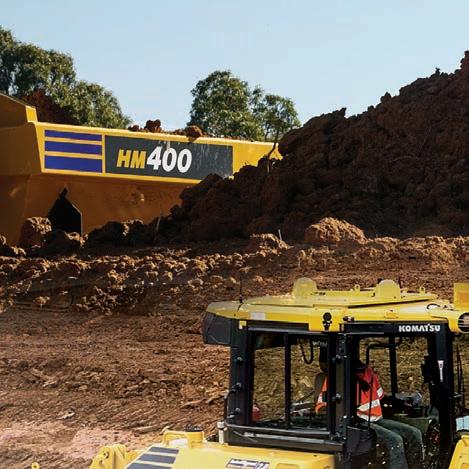




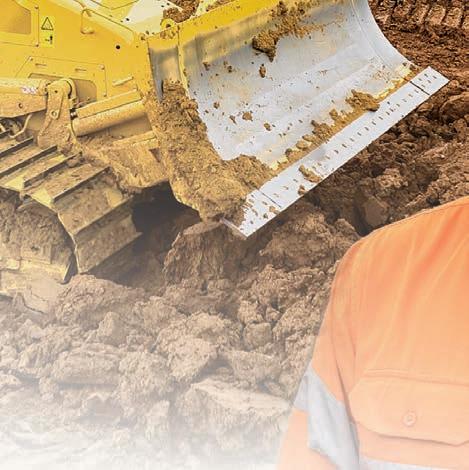





NEW DEAL SEALED FOR 2032 BRISBANE OLYMPICS INFRASTRUCTURE
The Queensland and Federal governments have inked a new deal that will refine and reallocate funding for priority projects necessary for the 2032 Brisbane Olympic and Paralympic Games, while also ensuring the suitability and longevity of infrastructure post-games.
As part of this agreement, the Federal Government has announced changes to the structure and breakdown of its $3.435 billion contribution to the $7.1 billion Games Venue Infrastructure Program.
Both the State and Federal governments will now work together to update 17 new and upgraded venues across Queensland. This includes works on the main Games stadium, as well as the National Aquatic Centre.
The main stadium at Victoria Park will become the new, world-class, 63,000 seat home to AFL and cricket in Queensland and attract major national and international events, leaving a lasting legacy for 2032 and beyond. It will host the opening and closing ceremonies, as well as the athletics events.
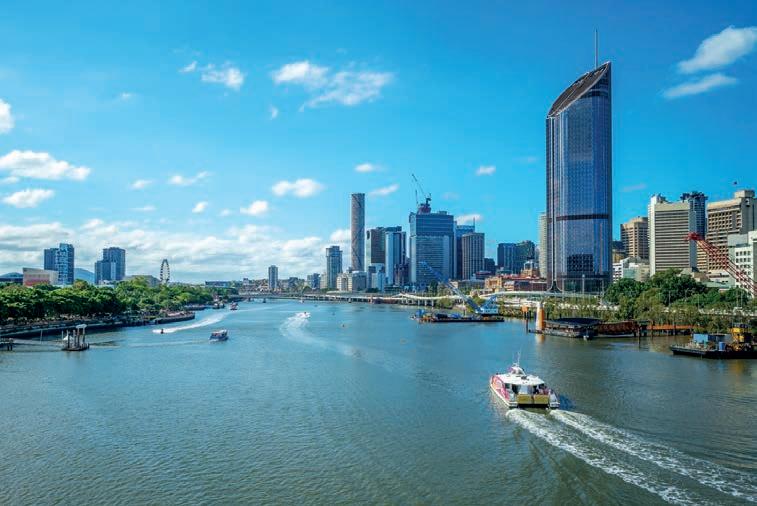
The new agreement has been reached following project validation work, which determines the Federal Government’s final investment, assessing that these projects can be delivered on time and on budget, represent a good use of taxpayer dollars, and will benefit Queensland for decades to come.
As part of the agreement, the Minor Venues Program has also been revised and
includes new projects such as a National Aquatic Centre, a Toowoomba Equestrian Centre, a dedicated para-sport facility and an expanded Queensland Tennis Centre.
Minor venue procurement has launched for work to commence at four key Games venues across the state: Logan Indoor Sports Centre, Moreton Bay Indoor Sports Centre, Barlow Park Stadium upgrade and Sunshine Coast Stadium upgrade.
CHAIR APPOINTED TO MELBOURNE AIRPORT RAIL STEERING COMMITTEE
The Melbourne Airport Rail Link (MARL) project has appointed Merren McArthur as the independent Chair of the MARL Steering Committee.
McArthur’s appointment follows a Memorandum of Understanding (MoU) being reached between the Federal Government, Victorian Government and Melbourne Airport earlier this year in which all three parties committed to establishing a Steering Committee led by senior officials from each organisation to progress the project.
As chair, McArthur will foster a collaborative and constructive environment, enabling the parties to work together to develop a clear and effective pathway for the successful delivery of the MARL.
McArthur is a Non-Executive Director and Chief Executive Officer with significant governance experience in the aviation, rail and broader transport and freight sectors.
Her experience includes leading Tiger Airlines, Virgin Australia Regional Airlines and Virgin Australia Cargo, as well as being a Non-Executive Director of Airport Development Group and National Intermodal Corporation, an Executive Director and Chair of the People and Safety
Committee of Queensland Rail, and a legal advisor to governments on commercial governance issues.

The Victorian Government said McArthur’s experience makes her well placed to navigate the complexities of this major urban infrastructure project.
Merren McArthur will lead Melbourne’s Airport Rail Project. Image: stock.adobe. com/oleksandr
Key projects for the new infrastructure include a new Brisbane stadium at Victoria Park, a national aquatic centre, and upgrades to venues like the RNA Showgrounds and the Queensland Tennis Centre. Image: stock.adobe.com/Richie Chan


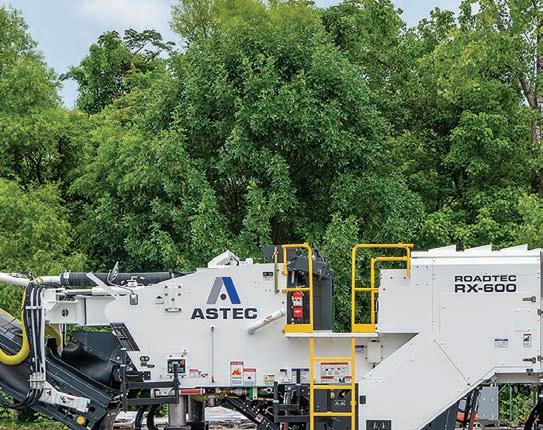
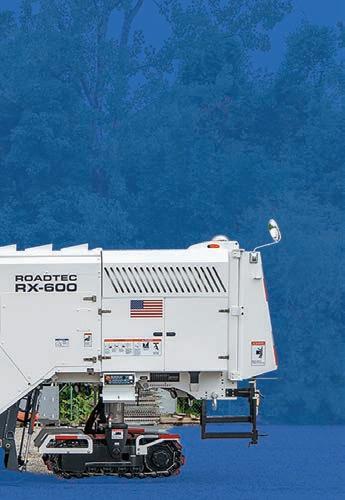

























SRE’s telescopic bitumen sprayers or our newly developed 8m fixed wing bitumen sprayers are available for mid 2026 delivery.
Fully compliant with all Australian regulations our sprayers meet all Austroads performance requirements for bitumen sprayers and are ready to go straight to work.
$10.7B INFRASTRUCTURE INVESTMENT REVEALED IN WA BUDGET
The Western Australian 2025/26 State Budget has allocated $10.7 billion investment in transport infrastructure over four years. Image: stock.adobe. com/Michael

Road Safety Program that aims to rollout upgrades on local government roads ($250 million). Upgrades to the Wanneroo Road Corridor will also receive $36 million worth of funding.
More funding ($107 million) will also support the expansion of the current ferry service on the Swan River, on top of a further $103 million to deliver a full transition of buses to an electric fleet.
This transition will also benefit from a $83 million investment into the production of electric buses and ferries in Western Australia.

The Western Australian Government’s 2025/26 State Budget includes a $10.7 billion investment in transport infrastructure over the next four years, aiming to increase connectivity and accessibility, all while reducing congestion.
Key road upgrades that will receive new or additional funding include works to widen and upgrade the Kwinana Freeway ($700 million), the Reid Highway-Erindale Road Grade Separation ($450 million), as well as more funding to support the Regional
EXTRA $600M ANNOUNCED FOR LOGAN AND GOLD COAST FASTER RAIL
The Queensland Government has announced an additional $600 million in funding for the $5.7 billion Logan and Gold Coast Faster Rail, which will support upcoming pre-construction works on the project.
This funding from both the Federal and State governments ($300 million each) will help the ActivUs consortium to deliver the Rail Package in this mega infrastructure project, following the finalisation of its Design and PreConstruction contract on the project a few months ago.
The project will see the number of tracks between Kuraby and Beenleigh
doubled from two to four, significantly improving service frequency and reliability for commuters. It also includes the removal of five level crossings; upgrading stations; and improving access and connectivity along the 20-kilometre project corridor.
The rail line between Kuraby and Beenleigh is a key capacity bottleneck on the network, where trains share a single track in each direction. During peak periods, all-stop Beenleigh trains need to be held to one side to allow Gold Coast express trains to pass through.
The Logan and Gold Coast Faster Rail project aims to unlock this bottleneck,
Further funding for improvements to the South Coast Highway ($25 million), Northam Pithara Road realignment ($25 million) and new SufCAT bus service ($18 million) was also announced.
Public transport was also a winner, with $152 million going towards the delivery of the Suburban Flat Fare, as well as $10 million to keep public transport free for students in 2026.
$152 million was also announced to establish the new suburban flat fare across the Transperth and Transregional public transport networks.

making it easier for commuters to access high frequency rail services.
This funding forms part of the 2025/26 Queensland State Budget.
The Logan and Gold Coast Faster Rail project is a key investment to support the Brisbane 2032 Olympic and Paralympic Games. Image: stock. adobe.com/Castigatio
INDUSTRY
INVITED TO DELIVER $2.24B WESTERN SYDNEY UPGRADES
Three major arterial roads in Western Sydney will be transformed as the region braces for an airport boom, with the State Government calling on industry to deliver critical upgrades worth $2.24 billion.
The infrastructure investment is expected to deliver safer, faster journeys for Western Sydney communities as new employment zones drive unprecedented growth, and comes as the Western Sydney International (Nancy Bird Walton) Airport nears completion.
The State and Federal governments are each providing half of the committed funding.
Transport for NSW is inviting experienced contractors to register their interest in designing and constructing upgrades to Elizabeth Drive, Mamre Road Stage Two, and Garfield Road East – key arterial routes that will transform connectivity.
Elizabeth Drive is a $800 million transformation which will deliver a two-lane dual carriageway to priority sections between Devonshire Road and Western Road.
As well as upgraded intersections providing
CONSTRUCTION KICKS OFF ON NSW CENTRAL COAST HIGHWAY
Main construction works to upgrade the Central Coast Highway-Tumbi Road intersection have started.
Work has officially begun to replace the existing roundabout with modern traffic lights and expand the highway to two lanes in each direction, to the project boundary.
This upgrade will address the bottleneck and improve traffic flow and safety on the Central Coast Highway between Wamberal and Bateau Bay.
The $65.5 million upgrade is being jointly funded by the Federal and New South Wales governments, with the Federal Government contributing $52.4 million, and the New South Wales Government investing $13.1 million.
The transformation is expected to slash travel times, improve safety, and boost the local economy with 125 construction jobs
The New South Wales Government has called on the industry to deliver critical upgrades worth $2.24 billion. Image: stock.adobe.com/Pawel Pajor

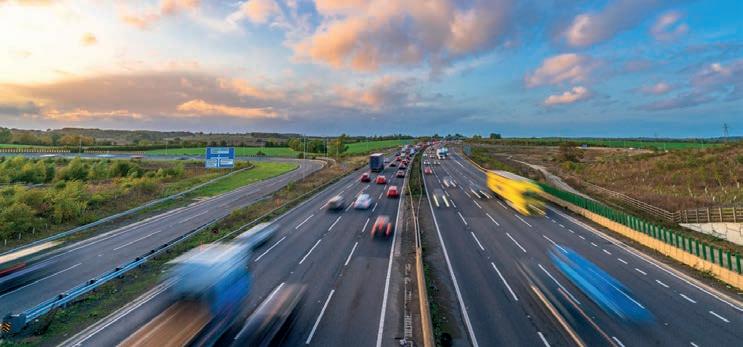
safer access to Kemps Creek, Badgerys Creek, Luddenham and the emerging Bradfield city.
Mamre Road Stage Two will continue following the work on Stage One.
This $1 billion investment will upgrade the road from Erskine Park Road through to Kerrs Road.
This will support the rapidly expanding employment zones along this critical corridor.
Investigation works are already underway between Erskine Park and Kerrs Road.
The Garfield Road East $440 million project is a key sub-arterial route between Piccadilly Street and Windsor Road.
It will be converted to a two-lane dual carriageway, improving amenity for communities in the North West Growth Area as housing development accelerates.
Environmental assessments for all projects will be publicly displayed later this year, with construction expected to commence following community consultation.
Industry submissions must be submitted to Transport for NSW.
The Central Coast Highway provides an important connection between the M1 Pacific Motorway and Gosford, from Gosford to Erina and The Entrance through to Doyalson. Image: stock.adobe.com/Rok


supported throughout the build. Upgrades include traffic lights replacing the roundabout, highway widening to two lanes each way north of the intersection, two right-turn lanes from Tumbi Road onto the highway, a right turn lane onto Tumbi Road from the Central Coast Highway southbound and extended left-turn capacity into Tumbi Road.
Other works include upgraded footpaths
and cycling infrastructure and relocated bus stops for better passenger access, with two existing northbound bus stops moved to a common location north of the intersection. Following extensive community consultation in 2021-2022 and preparatory works in 2023, Daracon Pty Ltd was awarded the construction contract in March 2025.
The project is expected to be completed in 2027.




Creating, connecting, and caring for communities


Fulton Hogan delivers high-quality infrastructure to improve the lives of people in Australia and New Zealand, every day.

We’re a growing, forward-looking and family-oriented business that’s investing in the talent of tomorrow.

Come and join our team.





Explore opportunities to join the team at at fultonhogan.com



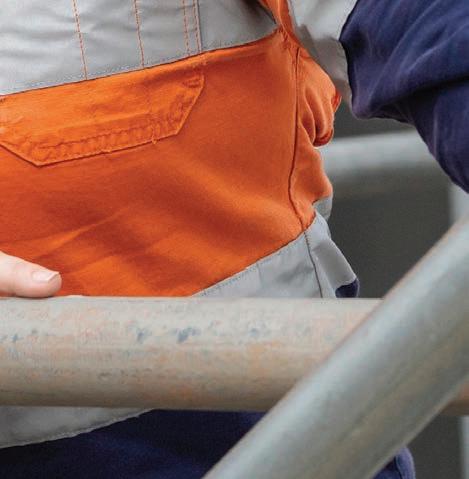






PREFERRED ALLIANCE NAMED FOR PERTH PRECINCT DELIVERY

The preferred alliance team has been named to deliver the design, development, site investigations and early works preparation for the Perth Entertainment and Sporting Precinct.
The preferred alliance consists of Seymour Whyte Constructions, Civmec Construction & Engineering and Aurecon Australasia.
The Perth Entertainment and Sporting Precinct will comprise of a multi-purpose entertainment precinct that will boost the region’s capacity to host a range of arts,
cultural and sporting events.
The project includes a new amphitheatre with a capacity for 15,000 to 20,000 people, complementing nearby existing venues and entertainment infrastructure, such as Crown Perth and Optus Stadium. The precinct will host and support official events, while also being open to the community year-round.
Consultation with community and stakeholders has already delivered hundreds of ideas, which will help to inform
the final design for the precinct.
Concept development will consider facilities to support live music and sporting events, including an annual Supercars event, cycling criterium racing and paralympic racing.
Further stakeholder and community input will be invited as the design progresses in the coming months. Early works will commence later this year, with construction works on the precinct expected to be completed in 2027.
WORK COMMENCES ON $19 MILLION TRAFFIC SOLUTION IN NSW
Works on a $19 million upgrade to several key intersections across the Woy Woy Peninsula in New South Wales have commenced.
The upgrades will transform three key chokepoints and cut travel times for the 22,000 vehicles that travel on Blackwall Road corridor every day.
Transport for NSW said the upgrades will future-proof the Peninsula’s critical transport spine as the Central Coast continues to grow.
On Blackwall Road and McMasters Road, new pedestrian-activated traffic lights on the south side of the intersection will be installed, as well as a new right-turn bay on the northern leg to reduce congestion. Both sides of McMasters Road will become left turn only onto Blackwall Road for improved safety on Memorial Avenue, Maitland Bay Drive and Barrenjoey Road.
Other works will include the installation
of dual right-turn lanes from Maitland Bay Drive to Memorial Avenue and the separation of left and right-turn lanes for motorists exiting Gallipoli Avenue.
The intersection of Blackwall, Allfield and Farnell Roads upgrade is currently being reviewed.
Transport for NSW will update the community when this has been finalised and will start consultation if required. The upgrade of this intersection will be the final stage of work for the project which is expected to be complete within two years.

The Perth Entertainment and Sporting Precinct (PESP) is a project focused on delivering a multi-purpose entertainment and sporting hub at Burswood Park. Image: stock.adobe.com/Michael Evans

LOGANLEA ROAD WORKS KEEP MEADOWBROOK ON THE MOVE

As the City of Logan writes, drivers are now enjoying smoother and safer travel along Loganlea Road in Meadowbrook, following the completion of a major road upgrade.
Logan City Council’s multi-million dollar upgrade of Loganlea Road between the Logan Hospital and the M1 on-ramp at Slacks Creek is complete. The $81 million project was funded by the Federal Government and Logan City Council.
A 2.5-kilometre stretch of Loganlea Road from the Logan Motorway overpass (just north of the hospital) to the M1 was widened to six lanes as part of the works.
Major works were carried out to improve vehicle and pedestrian access through intersections, while wider road shoulders north of Queens Road have made it easier for drivers to pull over safely.
New stormwater infrastructure and kerbing was installed to minimise the impacts of heavy rainfall along the roadway.
A new shared northbound pathway and improvements to the southern pathway have also made it easier to get around the area on foot, or by bike.
The project is the largest Council road
upgrade delivered in the city’s history.
Mayor Jon Raven said its completion was a major step towards improving safety and traffic flow along one of the city’s most important thoroughfares.
“Loganlea Road is one of the busiest roads in our city, carrying more than 42,000 vehicles every day and serving as a critical link between the M1, the

The opening of the road upgrade is already providing safer and more efficient journeys for locals.
Logan Hospital, and our newest areas of housing in the south of the city,” he said. “Improving traffic flow and the safety of the area was vital, but we also needed to deliver something that would service our growing city into the future. Teaming up with the Federal Government has helped us to deliver the upgrade our community deserves while also getting

An aerial image looking south on Golf Course Drive. Images: Logan City Council
more people from the hospital to the highway, every day.”
Other improvements made as part of the project include the construction of a new northbound lane and shared footpath along the Ray Hodgson Bridge over Slacks Creek. These works included the lifting and placement of 36 pre-cast concrete bridge decks, using a 300-tonne mobile crane.
Work have also delivered extended vehicle turning lanes in each direction at the intersection with Ellerslie Road and University Drive, new traffic lights at Queens Road and extended U-turn space for vehicles travelling north to the M1, a dedicated left turn lane onto the M1 at the Nujooloo Road intersection, as well as on-road 1.5 metre-wide cycle lanes (commencing at Queens Road).
New and upgraded bus stops, and fauna protection fencing from Queens Road along Slacks Creek Environmental Park, to minimise wildlife movement along the roadway, have also been delivered.
Member for Rankin Jim Chalmers said the Federal Government was partnering with Council to deliver the infrastructure Logan needs and deserves.
“This is a great example of how we’re working with the council to make Logan City an even better place to live and work,” he said. “I use this road regularly, so I know how important it is for the local hospital, university, TAFE and shops, which is why I’m so enthusiastic about delivering this upgrade in our area.
“We’re upgrading Loganlea Road to
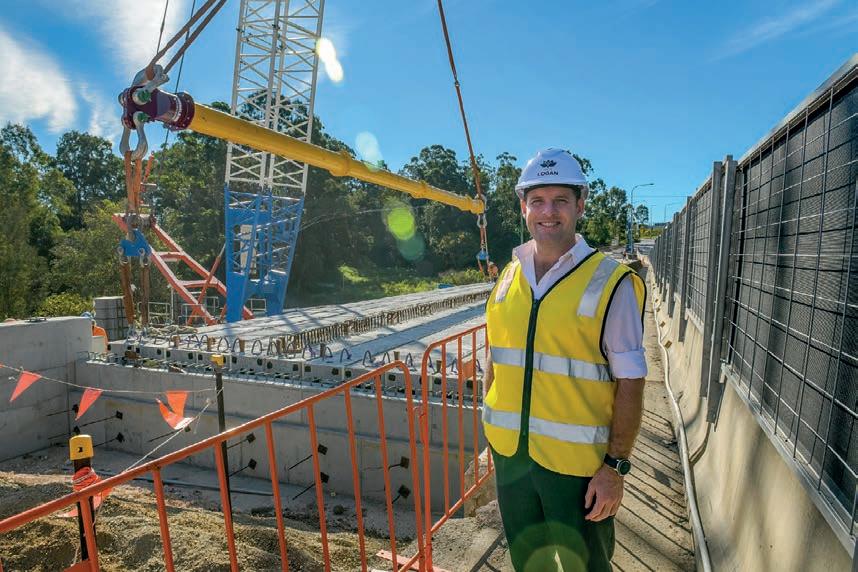
get people home quicker and safer and to ease congestion, but also to cater for growth in our community. Projects like this one are important for local jobs and the local economy but also for future proofing Logan City – ensuring we continue to create more jobs and more opportunities for more people in our community.”
Priority access will still be given to emergency vehicles, including ambulances, travelling along Loganlea Road.
Transponders in emergency vehicles can send a signal to the road’s traffic control system, which will hold a green
light to ensure faster movement through busy intersections.
Mayor Raven said this can cause extra waiting time on side roads, but encouraged drivers to be patient.
“Once an emergency vehicle has passed through, the traffic lights will return to their normal sequencing after a couple of cycles,” he said.
“I know local drivers will work with us to ensure ambulances can get where they need to be, and do their lifesaving work.”
More information on the project is available at: logan.qld.gov.au/loganlearoad-upgrade



add two powders at once up to 60 TPH of powder
option of adding two liquids
Logan City Council Mayor Jon Raven at the Loganlea Road bridge installation.



WRITING THE NEXT CHAPTER


STATE ASPHALT SERVICES HAS LONG PLACED ITS FAITH IN ASTEC MACHINERY FOR ITS EQUIPMENT REQUIREMENTS, WITH LONG-TERM RELIABILITY, CONSISTENT EQUIPMENT PERFORMANCE, AND STRONG CUSTOMER SUPPORT TURNING A ONE-OFF PURCHASE INTO A QUARTER OF A CENTURY-LONG PARTNERSHIP.
Regularity. It’s what many organisations in the infrastructure and construction spaces are striving for when it comes to their project pipeline.
Achieving regularity is easier said than done, but for some, it’s the result of a clear vision, as well as staying true to one’s philosophy.
It’s these factors that are best used to explain the continual and rising success of Sydney-based State Asphalt Services.
Jeffery Sherriff, Chief Operating Officer – State Asphalt Services, says the company is anchored by forward thinkers, complemented by a team that doesn’t
run away from a challenge.
“We are the largest independent asphalt producer in the market,” he says. “We pride ourselves on being able to have that full chain of custody, from the moment we make the asphalt, to the last stage of practical completion.”
The privately-owned company is particularly focused on major government and private sector infrastructure projects, providing holistic solutions across a variety of projects segments and disciplines.
But this wasn’t always the case.
In fact, the beginning of what is now a 25-year-old partnership can be traced back
to the company’s first steps, with one of State Asphalt Services’ first-ever pieces of machinery being a Roadtec RP150 paver from Astec.
As Sherriff explains, this kick-started things for the company in a serious way.
“When I started in the contracting business, I’d heard nothing, but good words said about Roadtec equipment,” he says. “And if you talked about asphalt placement in the industry, Roadtec was the first product range that people would mention.”
The RP150, complete with a Carlson screed, quickly found a companion in a second RP180, with both units holding the fort as

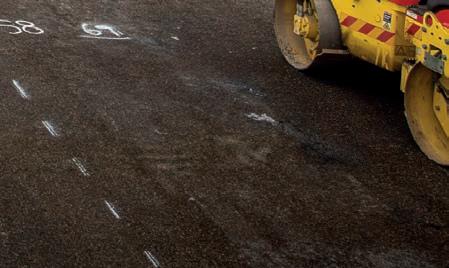
State Asphalt Service’s job and contract size continually increased.
With more work came a need to constantly upgrade the company’s fleet, leading to a number of additional Astec purchases over time.
Brant Volner, Project Coordinator – State Asphalt Services, has virtually been with the company since its inception. As he recalls, jumping on an Astec unit was a far cry from other equipment he’d used previously.
“When I got here and operated a Roadtec for the first time, it was like Christmas and your birthday had come at once,” he says.
“Straight away, the way that the machine was laid out and set was quite impressive. It was a great first impression.”
STRUCTURE OF STRENGTH
Although its foundation can be linked back to 2000, State Asphalt Services is actually a vertically integrated business that forms part of the Kypreos Group of companies.
Launched in 1970 by George Kypreos, the collection of companies is focused on delivering civil engineering and infrastructure services across Sydney. This includes asphalt production and contracting, spray seal, traffic management, plant hire and road profiling.
State Asphalt Services acts as the contracting division and has benefitted from a strong focus on self-sufficiency and growth, while keeping most processes in-house by reducing its reliance on sub contracting.
“George had a strong vision to be a selfdependant service provider, consistent with
that vertical integration,” Sherriff says. “We’ve had a lot of projects that have been around 100 million dollars or above. Now that we have a full suite of capabilities around road surfacing, we’re looking for more.”
The bulk of these connections have been established and cemented through word of mouth, quality project outcomes, as well as the vast experience of State Asphalt Services team. As Volner explains.
“We’ve had some great people work across the company who’ve been in the industry for a long time. That’s been a big factor in our strong relationships with some of those big contacts across tier ones and government,” he says.
State Asphalt Services’ relationship with Astec is no different.
MACHINERY REQUIREMENTS
In total, State Asphalt Services’ fleet now consists of 10 Astec units. This comprises an RP170ex, an RP175ex and three RP190ex pavers, as well as four SB2500 MTV (material transfer vehicles), along with one SB1500 MTV.
A number of these units have worked on several challenging jobs in challenging conditions. Regardless, each unit has shown no signs of slowing down.
“Some of our machines are north of 10,000 hours and are still going strong,” Sherriff says. “The first buggy we bought, we’ve still got, and that’d be about 18 years old. We still use it to this day.
“The feedback that we hear is that they’re well-balanced machines when you consider

Images:
Astec
State Asphalt Services will soon welcome yet another Astec unit to its fleet, in the form of the RP195Fx highway class asphalt paver.
The Astec and State Asphalt Services partnership has grown stronger with each machinery acquisition.
State Asphalt Services is building up a strong project pipeline for the remainder of 2025 and beginning of 2026.


the usability and user-friendliness. They’ve been able to perform through some of the hardest jobs and sub-bases.”
He adds that Astec’s constant introduction of new equipment, as well as the company’s efforts to mould and react to industry needs, means State Asphalt Services has gotten what it’s needed – when it’s needed it.
“They’ve certainly evolved their equipment over the years. It’s that commitment to development and moving with the times that has certainly been a reason for us coming back,” Sherriff says.
Despite these constant updates, Astec’s stamp can be felt on each and every unit.
“It’s almost like buying a new model of a car every year,” Sherriff says.
“You get a bit more advancement, but ultimately the machine still behaves the
same, and that’s because we’ve got such a thorough understanding on how to use and get the best out of them.”
As well as the quality and reliability of its equipment, another significant box that’s been ticked for State Asphalt Services has been after-sales support.
Between parts, training, and constant communication to check in, Volner says he and the rest of the State Asphalt Services’ team has well and truly felt a part of the Astec family.
“Whenever we need parts, they’re on our doorstop within 24 hours. I can probably count on one hand the number of times where that hasn’t happened,” he says.
“One of the biggest things for us is that we’re never treated like we’re just another client. Astec’s always focused on helping us
out, so much so that at times you feel like you’re their only customer.”
GEARING UP
FOR THE FUTURE
State Asphalt Services’ will soon add yet another Astec – Roadtec unit to the fleet, this time in the form of the new F Series (RP195Fx) tracked highway class asphalt paver.
With a 360-degree view, swing-out operator platforms, automatic lubrication, hydraulic pressure sensors, as well as its Astec and Carlson screed versions available, the RP195Fx is a heavy hitter in the Roadtec range, aimed at larger transport and construction works.
Sherriff says the purchase of the RP195Fx is part of a clear strategy to upgrade and expand the company’s fleet, to enable tendering of a larger scope and volume of projects.
“We’ve got a requirement at the moment to really start to renew the fleet,” he says. “The RP195Fx is likely the first of a few that we’ll need to purchase to deliver on that strategy.
“This unit in particular will be a good step forward for us, and we see a lot of benefits in Astec’s new series of tracked pavers.”
Greater visibility is just one benefit that Sherriff specifies as an advantage over previous units, as well as other options in the market.
“The RP195Fx is a lot lower set and has a lower profile, meaning it’s going to be much easier for our operators to get a good view of the site,” he says. “It’s really going to help us with our ability to do all sorts of different jobs.”














“In an industry where project overruns are commonplace and practices have remained largely unchanged since the middle of last century, Octant AI’s predictive capability is revolutionary.” Bent Flyvbjerg, Saïd Business School, Oxford University


ROADS REVIEW






THIS MONTH, WE ASKED THE INDUSTRY’S DECISION-MAKERS, WHAT FACTORS CAN HELP THE INDUSTRY BUILD UP MORE CAPABILITY TO DELIVER THE CURRENT PIPELINE OF CONSTRUCTION WORK?
RAQUEL RUBALCABA, A/DEPUTY SECRETARY, INFRASTRUCTURE PROJECTS AND ENGINEERING –TRANSPORT FOR NSW
The NSW Government through Transport for NSW is providing certainty for industry through a programme of major projects, both in delivery and in the pipeline. Most recently, Transport for NSW is calling for industry EOIs to design and construct more than $2 billion worth of upgrades along Elizabeth Drive, Mamre Road (2) and Garfield Road East. It comes as a major tender was awarded to Seymour Whyte Construction Pty Ltd to design and construct an alternate exit to the Hume Highway from the M5 at Moorebank. Transport for NSW strives to work closely with construction partners to foster trust and reliability. Some of this work includes working with industry in a pre-tender stage to identify potential issues and find solutions before formal tendering takes place. By providing this confidence, our construction partners can better train workforces and offer their workforces better employment security and incentives to invest in modern technologies and capital equipment.
Image: Transport for New South Wales


SARAH BACHMANN, CHIEF EXECUTIVE OFFICER – NATIONAL PRECAST CONCRETE ASSOCIATION AUSTRALIA
With record infrastructure investment across every Australian state, the challenge is no longer a lack of projects, but the capability to deliver them. Precast concrete plays a growing role in this pipeline, from bridges and tunnels to stations and noise walls. For the first time, targeted micro-credentials (MCs) about precast are available nationwide for workers manufacturing or working with precast. Whether on major transport builds or local upgrades, industry now has a scalable solution to lift capability, safety and quality. It’s a practical step forward and one the entire sector can benefit from. Details at nationalprecast.com.au

Image: National Precast

PETER ALI, CHIEF EXECUTIVE OFFICER – MUNICIPAL WORKS AUSTRALIA


To meet Australia’s growing construction pipeline, the industry must increase workforce capacity, update practices, and build resilience. Addressing the skilled labour shortage is essential. Procurement reform is also crucial. Clearer project pipelines, fairer risk-sharing, and collaborative contracts will give the industry the confidence to invest and achieve better outcomes. Other challenges include adopting new technology and sourcing sustainable materials, which will reduce reliance on imports and help control costs. Together, these changes will build the capacity needed to deliver Australia’s infrastructure future.
Image: Municipal Works Australia


MARK PIORKOWSKI, EXECUTIVE DIRECTOR, QLD/NT – AUSTRALIAN FLEXIBLE PAVEMENT ASSOCIATION
Building capability starts with clarity. As governments, particularly those in Queensland, invest record amounts in infrastructure, industry needs timely, structured visibility of upcoming work to plan with confidence. Forward-looking delivery programs – backed by transparent, geographic, and staged funding information – allow companies to retain skilled staff, align resources, and respond competitively when opportunities arise. When project pipelines are visible and predictable, industry can invest in training, grow local capacity, and deliver with greater speed and certainty. Whether for major transport builds or local maintenance upgrades, strategic visibility drives industry confidence and capability retention. It’s not just good planning – it’s nation-building.
Image: Australian Flexible Pavement Association

MATTHEW BERENI, CHIEF EXECUTIVE OFFICER – TRAFFIC MANAGEMENT ASSOCIATION OF AUSTRALIA
Delivering Australia’s record transport infrastructure pipeline demands more than funding. We must grow capability by attracting and keep a diverse workforce; embracing innovation and real-time data to lift safety and productivity; harmonising specifications across jurisdictions so skills are transferable; and forming genuine partnerships with government, contractors, suppliers and communities to share innovation.
Image: Traffic Management Association of Australia
If you or someone at your organisation is an industry leader and would like to be a part of this monthly column in 2025, please get in touch with Editor, Tom O’Keane: tom.okeane@primecreative.com.au

Enhance fleet management through innovation and sustainability

As a global leader in IoT and connected transportation, Geotab processes and analyses data from over 4 million connected vehicles, generating over 75 billion data points per day. It’s a huge amount of data, and it is most powerful when we have the right tools to securely and efficiently manage it. That’s why we have partnered with Google to leverage Google Cloud’s data analytics and machine learning solutions.



Championing
Innovation and Sustainability
Geotab has been awarded two Google Cloud Customer Awards for its achievements in the transportation sector. Recognition in both the Cross Industry and Sustainability categories underscore Geotab’s successful use of Google Cloud’s analytics to innovate and drive sustainable practices in fleet management.
Kirsten Kliphouse, the President of Google Cloud Americas says that the Awards are an opportunity to recognise the most innovative, technically advanced, and transformative cloud deployments across industries globally built on their platform.
In her congratulatory message to Geotab, she acknowledged Geotab’s role in “serving as an innovator for the industry”, which also highlights Geotab’s innovative integration of data to revolutionise the transportation sector, leading to transformative impacts across organisations and customers around the world.





Empowering sustainable transportation
As the world’s premier EV telematics provider, Geotab has demonstrated its commitment to reducing emissions through its Electric Vehicle Self-Assessment (EVSA) tool, which won Google Cloud’s Award for Sustainability.
The tool provides tailored EV recommendations to support businesses and governments in transitioning to electrified fleets. For two consecutive years, Geotab was also identified as a Cross-Industry winner impactful transformation facilitated by Google Cloud. The award also acknowledges the launch of the Intelligent Transportation Systems (ITS) and its flagship transportation analytics platform Altitude.
Altitude has been pivotal in supporting government agencies by offering actionable, privacyconscious data insights for city planning and transportation network enhancements.
Strong synergy of Geotab and Google Cloud show great potential
As a valued partner in the Google Cloud Ready - Sustainability validation program, Geotab plays a crucial role in accelerating sustainability programs and informing strategic decisions for future developments.
Geotab’s collaboration with Google Cloud delivers significant benefits, including real-time improvements in driver safety and behavior, advancement of sustainability goals, enhanced productivity and significant cost savings.
This partnership not only redefines fleet management standards but also illustrates the impactful role of technology in fostering a more sustainable and efficient transportation industry.
An industry-leading solution
Geotab’s partnership with Google demonstrates the company is at the forefront of leveraging data analytics and machine learning to enhance fleet management, drive sustainability and create safer transportation systems worldwide.
By integrating Google Cloud’s advanced analytics with its telematics expertise, Geotab is confident of continuing its lead in the development of sustainable transportation solutions, demonstrating the profound impact that innovative technology can have on the transportation system today.
OF APPROVAL TRANSPORT’S TICK
NTRO
(NATIONAL TRANSPORT RESEARCH ORGANISATION) CERTIFICATION IS EXPECTED TO SET A NEW STANDARD FOR EVALUATIONS ON THE PROFICIENCY, SUSTAINABILITY AND EFFICIENCY OF PRODUCTS, PROCESSES AND PEOPLE IN THE TRANSPORT SECTOR.
The knowledge gap between different generations of engineers, operators, builders and more continues to be a pressing issue throughout the transport and infrastructure sectors.
Michael Caltabiano, Chief Executive Officer – National Transport Research Organisation, says Australia’s national transport infrastructure requires – and thrives on –technical excellence. An important aspect that he fears may be diluted by such a knowledge gap.
“When you’re dealing with natural materials, as you are in a transport environment, you need on-site and hands-on skills. You need a depth of knowledge and an understanding of how natural materials operate under load,” he says.
“The public sector used to run that skills training. People would then migrate from the public sector into the private sector, with those skills in tow. As a result, the whole industry would improve. But that’s now stopped, and it’s been stopped for a long, long time.”

Caltabiano says that, in the three decades that have passed since the disappearance of such a pathway, few programs have been developed to take its place.
The result: an accelerated sector-wide and inter-generational knowledge gap.
“It’s the absence of such training, plus the overlay of privatisation of both maintenance and capital works, that’s led to this skills deficit,” Caltabiano says.
After identifying a need for change, the NTRO began looking at how such a program could be implemented effectively in the current landscape, as well as the skills that would need to be included in such a program.
It’s here that NTRO Certification was conceived.
NTRO Certification aims to address these gaps by providing structured, multi-level training that covers theoretical and practical
aspects of infrastructure construction, as Caltabiano explains.
“The NTRO has a core obligation as a publicly-owned enterprise to undertake knowledge transfer,” he says. “We created NTRO Certification because there was a gap, and as a result, the private sector had no avenue to get innovation done and implemented. But most of all, we created NTRO Certification as a one-stop shop for industry, as well as the public and private sectors, to certify products, people and processes.”
PRODUCTS
NTRO Certification works across these three key levels to offer a variety of evaluation services, each tailored to the application.
The product section of the certification focuses on validating product performance against current standards, while also ensuring that products do what they claim.
Covering materials, tools and technologies, the product arm of the certification aims to create new pathways for innovative products, while also potentially influencing and creating new standards that could be
for local road authorities and state governments, but it also helps to create stricter control around the variability of quality.
Using bitumen as an example, Caltabiano says an NTRO Certification is a stamp that assures product quality.
“The sources of bitumen have changed fundamentally over the past 20 years,” he says. “We don’t refine any more in Australia; everything’s fully imported. So, what does that mean for quality? What does it mean for performance in the field?
“Similarly with the focus on green cement, how is it produced and what are the performance characteristics? When can it successfully be used?
“We’ve spent a lot of time thinking through the current issues with variable material quality in the bitumen, asphalt and concrete sectors. NTRO Certification aims to give State Government, road owning authorities and contractors greater confidence when they’re answering these questions.”
NTRO Certification has been developed by engineers and experts in the industry.
It’s the NTRO’s hope that the certification program will lead to the development of higher quality transport infrastructure.

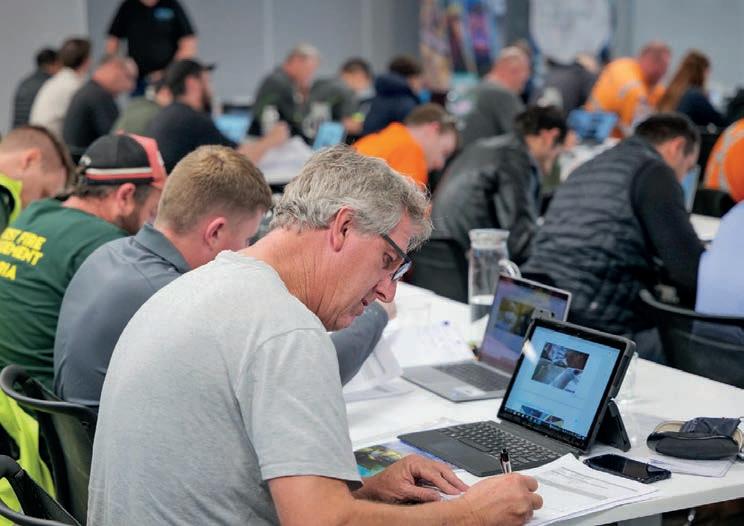
PEOPLE
Comprehensive skills development and knowledge transfer is the name of the game for NTRO Certification’s peoplecentric evaluations.
“The ‘people’ certification is all about development and certifying core competencies,” Caltabiano says. “It enables people to ask themselves, ‘Can I do a spray seal design? Can I lay asphalt? Do I understand how to deliver effective drainage on a construction site?’ ”
But how do you build a program for differing experience levels and backgrounds?
NTRO delivers training through three knowledge levels: “introductory knowledge” (level one), “foundation knowledge” that teaches how standards are applied (level two) and “applied knowledge” for complex scenario handling (level three).
“Introductory knowledge” is an online training module, focusing on establishing a fundamental understanding of basic concepts. “Foundation knowledge” that teaches how standards are applied is a mix of online and in-person training and teaches individuals about applying knowledge to current industry standards in a more practical setting.
The last level, “applied knowledge” is conducted fully in person and instructs participants on how to deal with real-world challenges, such as unpredictable weather, assessing material quality on-site and critical decision making in other variable scenarios and conditions.
For those who have been in the sector for some time, the option is available to skip straight to level three. For those new to the
sector, the program provides a cross-section of essential skills, once complete.
Caltabiano says the long-term impacts of this training and development shouldn’t be underestimated, particularly its potential impact on retaining and encouraging skilled individuals in the transport sector.
“Building capacity means more than just upskilling. It means enlivening the next generation of engineers who want to be a part of the transport infrastructure space,”

Above: An NTRO Certification is highly regarded as an independent stamp of approval.
one of the core responsibilities of the organisation itself.
The NTRO hopes that a specific focus on processes would help to streamline practices that encourage efficiency and compliance.
Just one example is better supporting local government to understand what data needs to be collected, and how it can be used effectively, to measure infrastructure conditions.
The NTRO will also soon launch a suite of standards and specifications aimed at local government, once again reaffirming the role the NTRO plays in establishing and improving standards to guide positive progress and innovation across all transport modes nationally.
“We’re also globally connected as an enterprise,” Caltabiano says. “We’re regularly looking to, and hearing from, our partners globally to make sure that we’re on top of best practice, in line with what’s happening in the rest of the world.
“BY HAVING HIGHLY TRAINED PEOPLE WHO UNDERSTAND THE PERFORMANCE OF NATURAL MATERIALS AND HAVE ACHIEVED THIS CORE COMPETENCY, WE’LL ALL BE ABLE TO LIVE AND USE HIGHER QUALITY INFRASTRUCTURE.”
he says. “If they get excited and enticed through that knowledge development, then they’ll likely remain in the sector for the long-term.”
Therefore, creating benefits for all.
“By having highly trained people who understand the performance of natural materials and have achieved this core competency, we’ll all be able to live and use higher quality infrastructure,” Caltabiano says.
“That means more value for money, more innovative processes, and ultimately enabling the community to do more, with less.”
PROCESSES
The ‘process’ segment of NTRO Certification relates to the development of standards and specifications for the transport sector,
“The NTRO has spent a lot of time thinking through who’s doing what really well, and how we can adopt that. Just one example is the International Road Federation, which is excellent in road safety auditor training. It’s a global standard that’s proven to be successful, so we should be looking to simply adopt it. We don’t need to invent something for Australia.”
It’s a constant game of push and pull, but Caltabiano says today’s hard work will lay the foundation for the next generation of transport innovators.
“We need to be continuing to develop and keep up to date – and in some cases –be slightly ahead of where the industry is, in order to point it in the right direction,” he says.
“That is, and has always been, a key driver for the NTRO.”



THE POWER TO GRADE SMARTER
BUILT FOR THE WORK THAT MATTERS
Transformed through evolution, the ultimate species delivers more power, productivity and precision than ever before.




The BELL Graders
Built for performance where it matters most – on construction sites, council roads and out in remote mining zones. Powered by a quiet, e cient Cummins engine and smooth ZF transmission, Bell Graders deliver the control, comfort and durability needed for tough grading work.
With advanced grading technology, a rugged build and full nationwide support, Bell Graders are ready to take on your toughest jobs.
Hitachi Construction Machinery
Geotab’s Marketplace has a range of dashcam’s available for customers.






TELEMATICS INTEGRAL
GEOTAB IS SHIFTING TO AN ALL-IN-ONE TELEMATICS PLATFORM, PROVIDING FLEET MANAGERS WITH THE BEST FOOT FORWARD WHEN IT COMES TO SAFETY AND RELIABILITY.
As transport and data industries continue to modernise technology, one tool in particular has proven to transform roads worldwide: all-in-one telematics platforms.
At the forefront of this evolution is Geotab, one of the global leaders in connected transportation solutions, which is now rolling out its integrated safety platform across Australia.
The shift to an all-in-one video and telematics system can redefine how fleet operators manage safety, risk, and efficiency.
The all-in-one system forms Geotab’s holistic approach to move from reactive to proactive when it comes to safety and maintenance.
It combines video footage, AI- (Artificial Intelligence) driven analytics, and engine diagnostics, providing fleet operators with a full picture of every drive.
In the unfortunate case of an incident, Geotab’s all-in-one integrated system will not only capture what happened on the road, but also helps to uncover why it happened.
Alkan Ciftci, Business Development Manager for Geotab, says Geotab saw a gap in the market.
“Fleet managers are no longer satisfied with simply knowing there was a harsh braking event. They want to understand why it occurred,” he says.
Traditional telematics systems provide data on isolated events, such as harsh braking or engine faults, but without
video footage or AI, there is room for misinterpretation.
“Harsh braking could occur because the driver was distracted and wasn’t aware of what was in front of them,” says Ciftci. “Or it could have occurred because another road user cut in front of their vehicle, and they hit the brakes to protect themselves and that driver.
“So was the driver distracted or were they avoiding a collision with another vehicle?”
The all-in-one platform uses a mix of forward-facing, driver-facing and external cameras, depending on the clients’ operational needs. And these aren’t just standard dashcams.
Using AI technology, the system can also detect potential distractions
Images:
Geotab
Geotab’s all-in-one telematics platform is ideal for fleet managers looking to have all of their safety and maintenance needs monitored in one place.

such as fatigue, phone use and even eating. Ciftci says the program will alert the driver if it notices any of these distractions.
However, it’s important that the alert doesn’t disrupt them further. Therefore, finding a balance is key.
“You have to be careful with driver prompts, if a driver gets audible alerts it could add to their distraction level,” says Ciftci.
In the instance where an incident has occurred, Geotab’s model can once again use AI to scour through the footage in the lead-up to the collision.
Ciftci says reviewing hours of footage is something humans will never have the capacity or patience to do, and therefore the tool is a time and cost saver.
“It’s not big brother style where the whole trip is constantly being watched. In the case of an incident, the footage can be reviewed,” he says.
“If a truck has a driver facing camera, the program can look at an incident and determine the cause leading up to it.
“It will look at things like the driver’s head and position of their eyes. For example, if their eyes are downcast, there is a good chance they were either falling asleep or looking at a phone.”
With this technology, Ciftci says risky behaviour can be coached, and good

communicate with a driver on a rural road, as they had to rely on satellite phones to communicate.




“Even though we have mobile phones now, cellular coverage is still a problem around some parts of the nation,” Ciftci says.



With improved connectivity, fleet managers can identify and respond to incidents even in areas with limited coverage.

With Australia’s long-standing expertise in both vehicle technology and telematics,



Geotab expects the region to be a leader in the global roll out of integrated fleet safety systems.




In addition to connectivity, fleet operators around the country are experiencing challenges getting deliveries to destinations on time and having drivers meet their maintenance schedules.


behaviour can be rewarded. “Using this system, we can predict risk or know with a lot of certainty why an incident occurred, based on the information we have,” says Ciftci.
“Ideally the driver could get help before an incident occurs.”
Prior to Geotab integrating the all-inone model, Ciftci says the team noticed a rise in drivers installing their own cameras as a safety net.
Ciftci says Geotab provides rich engine data that allows fleet managers to address potential maintenance requirements ahead of time, avoiding breakdowns on the road.
This information can be accessed through two of Geotab’s platforms: its centres for Safety and Maintenance.
With data from over 4.8 million connected vehicles, fleet managers can benchmark their operations and see how their fleet compares on risk and vehicle health.
“IT WILL LOOK AT THINGS LIKE THE DRIVER’S HEAD AND POSITION OF THEIR EYES. FOR EXAMPLE, IF THEIR EYES ARE DOWNCAST, THERE IS A GOOD CHANCE THEY WERE EITHER FALLING ASLEEP OR LOOKING AT A PHONE.”
“Drivers want to have the footage there in the case of an incident to prove they weren’t in the wrong,” he says.
“It can be used to exonerate the innocent and of course identify the cause if the driver was at fault.”
LOCAL CHALLENGES
Ciftci expresses that although the shift towards all-in-one communications is global, Australia presents unique challenges.
“We are a huge continent and therefore connectivity can be challenging,” he says.
Ten years ago, it was difficult to
The Maintenance Centre provides fleet managers with the critical maintenance information for the fleet, including track codes, upcoming service needs and potential breakdown risks.
Alternatively, the Safety Centre provides driver risk levels, allowing managers to address behaviours and reinforce safety policies.
Ciftci says that together, these tools form a proactive management system designed to reduce downtime, improve delivery reliability, and enhance driver wellbeing.







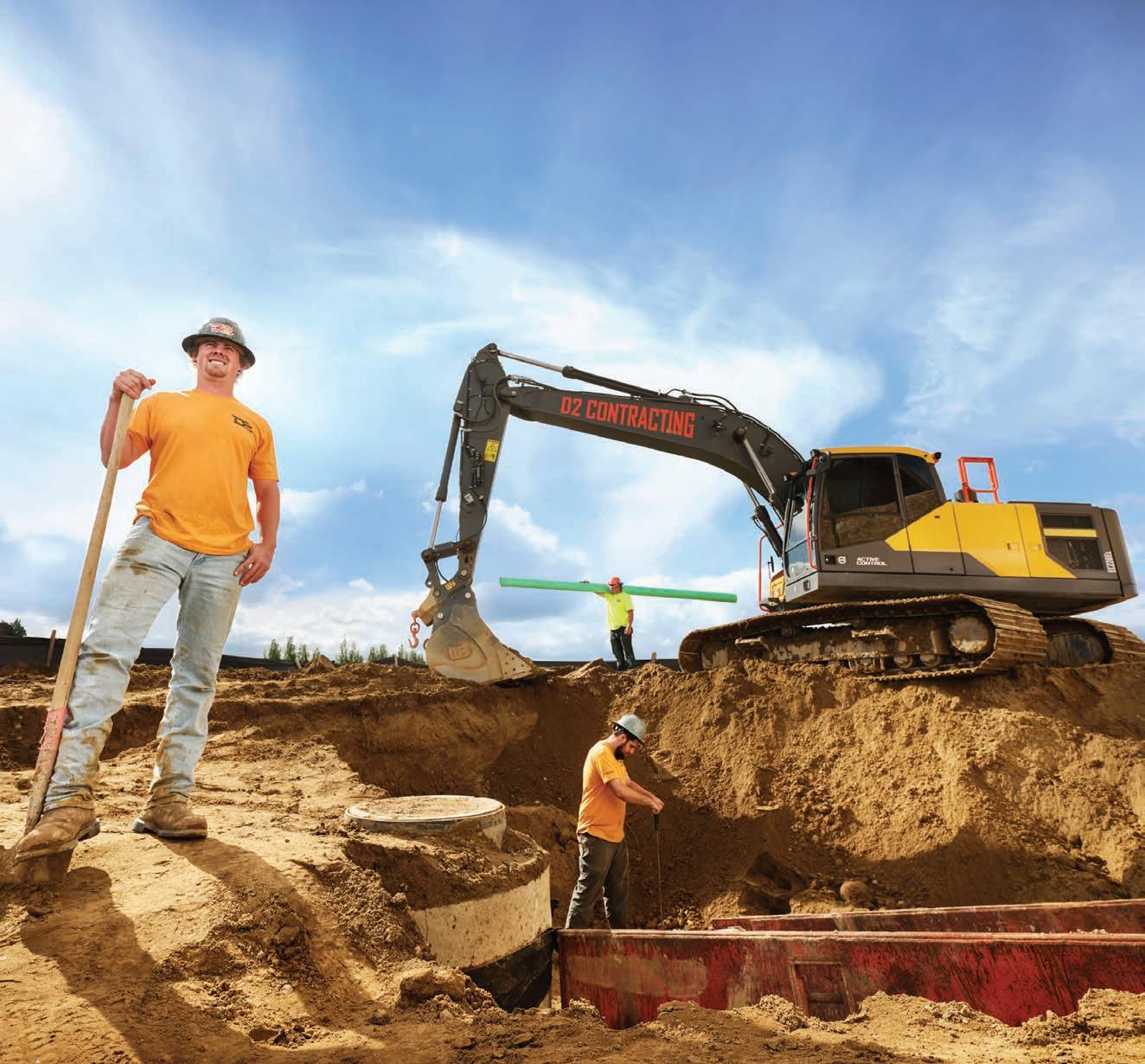

EVERYWHERE YOU GO
WORKS ON THE HOBART AIRPORT HAVE SIGNIFIED A SHIFT IN BEST PRACTICE WHEN IT COMES TO THE DELIVERY, STORAGE AND APPLICATION OF POLYMER-MODIFIED BITUMEN. SUPPLIER SAMI BITUMEN TECHNOLOGIES AND HEAD CONTRACTOR DOWNER REFLECT ON THE CHALLENGES AND SUCCESSES OF THE PROJECT.
For rural and remote road, highway and airport works, bitumen supply and transport can often be a logistical challenge.
Proximity to binder manufacturing facilities, duration of the project, as well as environmental factors can dictate what is and isn’t possible when it comes to bitumen transport.
That is, until now.
Brad Richards, State Manager Southern Region – SAMI Bitumen Technologies, says the company now has a solution that can deliver on demand high-quality binders, wherever the customer wants it.
“SAMI goes above and beyond to make sure we meet our client’s needs, and then we go the extra mile to make sure that we make the process as stress-free, easy, and streamlined as possible,” he says.
To deliver on this promise, SAMI has established a line of bitumen containers, each equipped to maintain bitumen at a specific temperature, ensuring product quality throughout transportation and storage.
These 32,000 litre capacity containers, which are able to cater for multiple material types and specifications, mean contractors no longer need to be concerned about extended truck waiting times or complicated
The container setup means contractors can have product that’s up to temperature and readily available onsite, when bitumen tankers aren’t viable.
logistics. The containers provide a flexible, reliable storage solution.
This solution has already proven successful on challenging projects, showing its potential to transform how bitumen is transported and managed in infrastructure development.
A NEW FRONTIER
As Daniel Anile, Project Director – Hobart Airport Upgrade Project, from the Downer Specialised Pavements and Projects (SPP) team explains, recent highly technical works in Tasmania have been enabled through the collaborative partnership between SAMI and Downer. Breaking new ground in the material transport and quality control of regional and remote projects.
“The project aimed to upgrade Hobart Airport to accommodate larger, widebody aircraft, unlocking tourism and trade opportunities for Tasmania,” he says.
“This required a strengthening of the main runway, widening of some taxiways, construction of a brand-new taxiway, as well as upgrades to the existing parking stands and construction of a Code E concrete parking bay. The project had to be completed within 12-months, requiring work to begin quickly and continue year round without disrupting aircraft operations or compromising quality.”

One glaring test was the transport and storage requirements to ensure availability of enough premium PMB (polymer-modified bitumen) to cater for the works. As Riaan Van Dyk, Construction Project Manager – Downer SPP explains.
“One of the biggest challenges we faced was that in Tasmania, high spec polymer modified binders are not commonly used. Standard grade binders are typically preferred due to the local supply chain limitations, colder climate and challenging logistics,” he says.
“So, we knew from the outset that getting premium quality binder on site was going to be a significant challenge in its own right.”
With no binder manufacturing facilities and traditional stationary tankers proving ineffective due to the project’s timeline and remote location, the team needed to think

SAMI’s bitumen container solution can cater for projects of all scopes, environments and regions.

outside the box to guarantee a suitable bitumen supply.
Accordingly Downer joined forces with SAMI Bitumen Technologies, to develop a unique and optimised solution to overcome one of the project’s largest challenges.
“Adding to the challenge, PMB products have a relatively short shelf life. With this in mind, Downer needed an experienced and capable partner. SAMI proposed the establishment of a purpose-built mobile bitumen storage facility located on the Hobart Wharves, consisting of 33-tonne capacity containers, each capable of storing, transporting and conditioning of either straight bitumen or PMB.”
Arranged in rows comprising 10-12 containers each, this provided a heated and transportable option, leading to greater flexibility. All the while enabling precise temperature management during both transportation and storage.
Each of these containers was loaded in Melbourne before being processed, shipped and delivered to Hobart where they were then transported to site.
Each of these containers held SAMI’s highest quality airport-grade A10E binder, a product that Richards says has already become a highly regarded offering in the market.
“SAMI has a fantastic reputation in the industry of having quality binders,” he says.
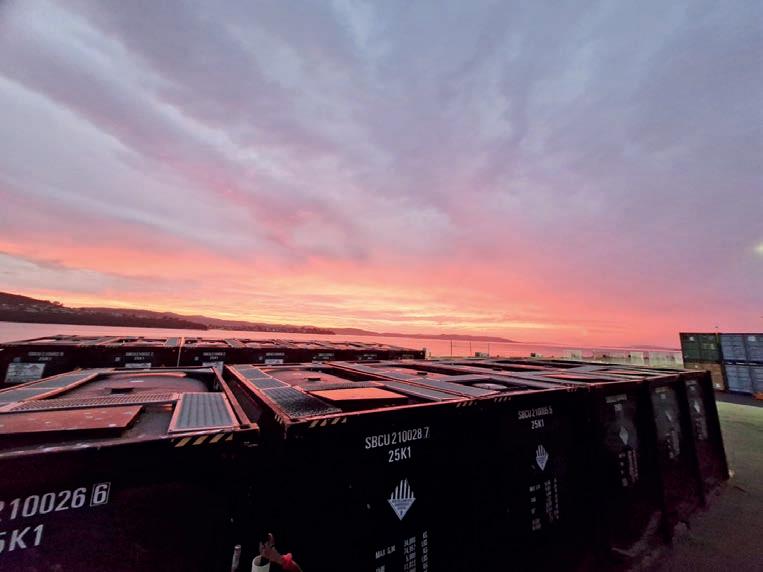
“So whenever there’s a special project, or even a challenging project, people reach out to SAMI because they know that the quality is going to be second to none.
“SAMI and Downer did a lot of joint research prior to the start of the project to optimise the properties of the binder that SAMI manufactured, so that it could survive the trip and the reheating process and ensure it comfortably exceeded the exacting airport specification requirements. Pleasingly, with over 5000 tonnes of product delivered to Downer’s site, all were delivered with specification and all were delivered on schedule and as per plan.”
From the customer’s perspective, Van Dyk adds that regular communication and alignment on safety values between the two
Constant communication was key throughout the delivery of the project, enabling all involved to stay up to date with project requirements.
companies played an essential role in the safe and successful delivery of the project.
“SAMI had live information obtained from Downer’s daily bitumen testing, and based on that information, they could make tweaks to the formulation back in the factory,” he says.
“SAMI was great in understanding our requirements and how to best modify the binder to get the best possible results.”
Regular project meetings were held between Downer Construction Manager Billy Clark and SAMI Project Manager Samuel Wright, reviewing the technical, safety and delivery performance to date, along with weekly, monthly and a whole of project look ahead programs, providing both immediate and long-term forecasts, and ensuring that
Images:
Downer
all project stakeholders were across project progress and future requirements.
HAND IN HAND
Samuel Wright, Project Manager – SAMI is part of a wider project team that’s specifically focused on delivering works where SAMI’s container solution is best suited.
The team’s primary responsibility is to create efficient, adaptable storage facilities that can be quickly deployed in remote or challenging locations. The team handles the entire logistics chain, from container preparation and heating to transportation across multiple modes, such as trucks, boats, and trains.
They work closely with clients to manage project requirements, providing real-time communication and rapid problemsolving capabilities.
Wright says the team’s expertise lies in their ability to handle complex logistical challenges, with a small, highly skilled group that can quickly adapt to changing project needs. All the while supporting a solution that enables significant cost savings by allowing transport vehicles to quickly deliver, rather than being stuck on-site for extended periods.
He says it’s a growing aspect of SAMI’s operation, and one that he sees as a key contributor to best practice project delivery in the future.
“When we were halfway through the project, it became relatively easy because
everyone knew what had to happen, we had our routine and our meetings, and we were constantly in touch with each other,” he says.
At every step a SAMI representative was co-located with the project team, providing on-site expertise and guidance to site coordinator Jeffrey Burnet, responsible for offloading bitumen to Downer storage tanks.
“It didn’t matter what company was on your shirt, it was just ‘let’s work together to get the job done’. When it comes to that communication, I can confidently say it was one of the best projects I’ve come across, especially for a project where we had to deliver 5000 tonnes of bitumen.
“We finished two weeks early with the bitumen supply on a project that a lot of big names said couldn’t be done, and we went into it knowing that it was going to be a challenge. At the end of the day, everything went to plan and everyone was happy.”
By offering a scalable, innovative solution, SAMI’s project team is not just providing a service, but also fundamentally transforming how bitumen logistics can be managed in infrastructure projects, creating new possibilities for transportation and storage.
Richards adds that all project stakeholders were satisfied with the outcome, a reflection of the “great” collaboration and communication between the different parties.
“It’s rare that you get a project where everyone who’s worked on it can walk
“IT’S RARE THAT YOU GET A PROJECT WHERE EVERYONE WHO’S WORKED ON IT CAN WALK AWAY AND COMFORTABLY SAY ‘THAT WAS A REALLY SUCCESSFUL PROJECT’. IT’S EVIDENT HOW SUCCESSFUL YOU CAN BE WHEN YOU WORK TOGETHER.”
away and comfortably say ‘that was a really successful project’. It’s evident how successful you can be when you work together,” he says.
Feedback from Downer has been overwhelmingly positive, with SAMI’s container division also benefitting from additional offers and tenders off the back of these works.
Reflecting on the works, Van Dyk says the container method is one that Downer will likely consider for some of its future projects, yet another milestone in what continues to be a growing professional relationship between Downer and SAMI.
“Downer and SAMI have both proven that it’s possible to take on difficult projects, especially regional and remote projects, and deliver high-quality outcomes, even when the use of bitumen tankers simply wasn’t feasible,” he says.
“It opens up a lot of confidence and possibility with a method like this, being able to show that you can successfully deliver in a logistically challenging place like Tasmania, where you don’t have the local refineries or blending plants to meet the bitumen supply requirements.”
For SAMI’s bitumen container line, Richards believes this is just the beginning.
“We’re really looking to open up new markets in Australia and make them more accessible to having high quality binders on demand, where the customer wants it,” he says.
“It’s really opened some big doors for our customers, to allow them to target projects that they wouldn’t normally go for, because

Downer is considering using the mobile bitumen containers for works in the near future.
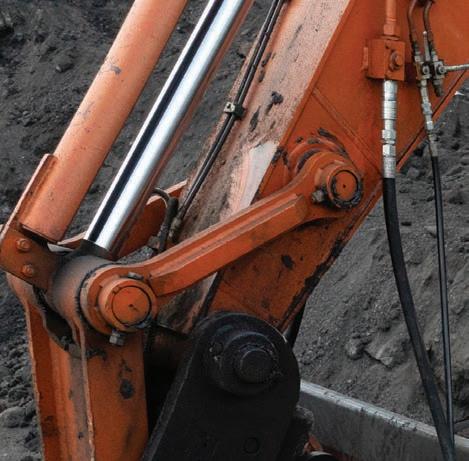
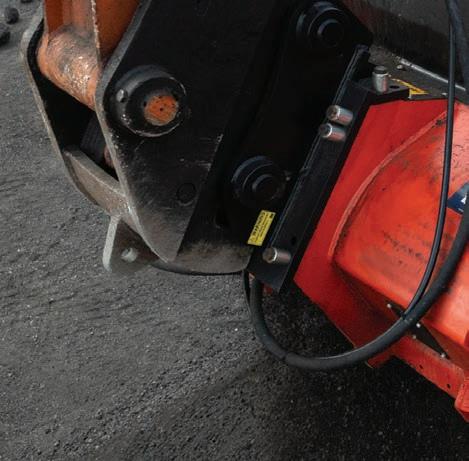


ALLU ASPHALT BUCKET – BUILT FOR RAP. DESIGNED FOR RESULTS.

Unlock the full potential of reclaimed and coldmilled asphalt with the ALLU Asphalt Bucket – a next-generation hybrid screening solution engineered for maximum efficiency and sustainability.
One-step processing – crushes and screens simultaneously
High productivity – up to 250t per hour
Hybrid blade tech – superior material separation in a single pass
Robust build – reinforced for heavy-duty asphalt applications
Fits your fleet – suits 25–45t excavators and 15–30t wheel loaders




Launching in Australia Q4 2025. Register your interest today with your local ALLU dealer: The hybrid blade setup – a mix of screening and crushing blades – enables the bucket to crush clumps, screen fines and separate oversized particles all in a single pass, eliminating the need for pre-crushing or secondary equipment.


THE CHERRY ON TOP
THE EXPANSION OF MATTHEWS BROTHERS ENGINEERING’S HIRE DIVISION HAS SIGNALLED THE START OF A NEW DIRECTION FOR THE COMPANY, WITH MORE SOLUTIONS AND SUPPORT ON THE WAY.
Across Australia, federal, state, territory and local governments spend about $30 billion annually on road works (Bureau of Infrastructure and Transport Research Economics). This comprises expansions, upgrades and maintenance.
The Safer Local Roads and Infrastructure Program – established by the Federal Government to deliver safer and more productive roads nationally – offers at least $200 million annually for such works, creating significant opportunity for local players in the sector.
For some, purchasing new bitumen sprayers to cater for these works isn’t always financially feasible, and bitumen sprayer hire is limited.
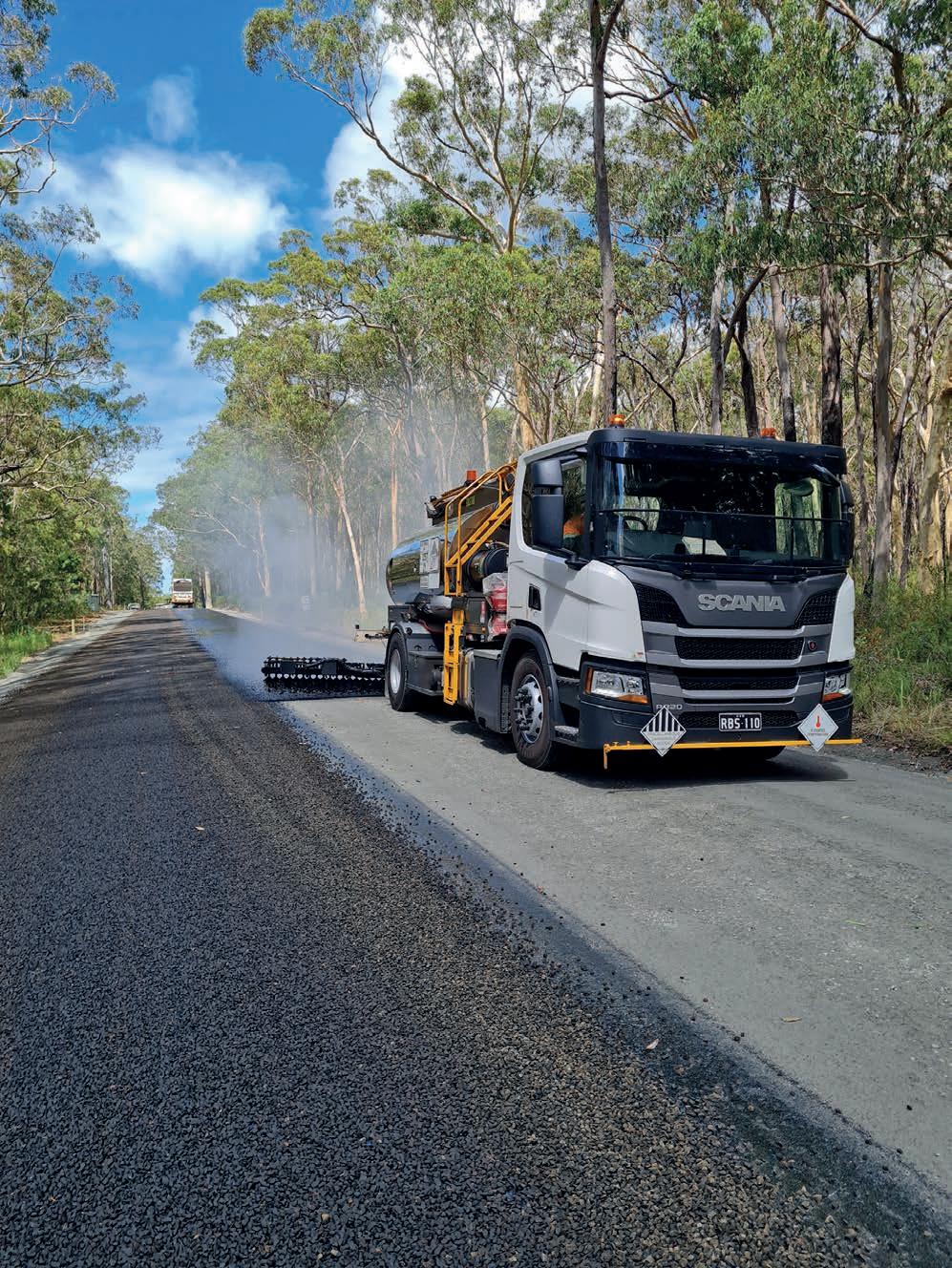
This is a space that Matthews Brothers Engineering is successfully navigating.
The bitumen sprayer, road tanker, tack coater, melting tank and aggregate spreader manufacturer’s hire division is far from new. In fact, its origins can be traced back to 1972, when the company filed its Certificate of Incorporation of Proprietary Company submission.
Since that time, Matthews Brothers Engineering has grown into a household name, but this is not the case with its hire division.
It’s for this reason that the company is looking to grow its already strong range of bitumen spraying equipment, specifically for hire. As Sally Rolfe, Operations Manager –Matthews Brothers Engineering explains.
“There is really no one else actually hiring out bitumen sprayers in the market today,” she says.
“But this is more than just filling a gap in the market. It’s about showing the best that we have to offer.
“It’s predominantly to service short-term client needs.”
Whether a contractor is taking on extra work, a new project type, or hoping to cover for a downed unit, this short-term solution is more than just a temporary fix. Instead, it’s a “get out of jail free card”, that Rolfe says has been curated to satisfy industry and operator requirements.
Equipped with a high-quality unit, with the latest technological, safety and efficiency features, contractors can be effective on-site with dry hire. This is thanks to the ease of operation and control provided by Matthews Brothers Engineering’s sprayer units, an ideal combination when paired with an experienced operator.

Matthews Brothers Engineering will soon welcome additional units to its existing hire range.


All of which is supported by a team headed up by Jake Hally, Matthews Brothers Engineering’s Service and Maintenance Coordinator.
Hally is responsible for overseeing and ensuring technical support for customers during the hire period, including diagnosing and fixing issues as they pop up.
Each unit also receives a pre-hire equipment inspection, as well as an equipment verification to make sure all features are operational.
The team also offers a walk-around the equipment to familiarise operators with sprayer functions, with operational guidance tailored to different experience levels.
Once the unit has been returned following its hire period, the team, under Hally’s supervision, also conducts thorough servicing across hydraulic functions, valve replacements, air actuator maintenance and more, making sure it’s ready to go for the next job.
Hally says that every equipment hire is in many ways a first impression, one of the main reasons why the team takes great pride in providing fully-functional and highperforming spraying units.
“We want to offer our hire clients the best possible version of ourselves,” he says. “It’s about making sure that we can provide the highest-performing gear, as frequent as possible.”
A big part of this mission is constantly updating the division’s capacity and
capability, one of the reasons why Matthews Brothers Engineering will soon add two new 6000-litre units to its existing range.
Sporting a Scania P320 chassis and single rear axle for greater manoeuvrability, these 6000-litre capacity spraying units are well suited to metropolitan and regional jobs alike.
“The better turning circle and greater accessibility are the main reasons why the 6000s have been popular in metro areas,” Hally says.
“It’s also less daunting for operators who aren’t full-time truck drivers.”
Hally says these are the first steps in Matthews Brothers Engineering’s gradual fleet replacement strategy, which will include additional 10,000-litre units in the near future.
Standardisation is also the goal, with the company’s control systems, diesel package burners, temperature control functionality and safety standards to be consistent across all units.
“We want to simplify and improve the customer experience, that’s why we’re looking to standardise features like the classic control system,” Hall says. “Importantly, it gives potential customers a taste of what to expect from some of our wider range.”
WHAT TO EXPECT
With these new spraying units in tow, as well options for a chip sealer, Matthews

Brothers Engineering’s hire division is not an alternative to purchasing, rather a backup option that can answer the call, should circumstances dictate.
With a growing wait list, there’s plenty of operators and contracts already in line, but Rolfe says the more the merrier.
“I’m excited about getting greater standardisation across the fleet and getting more trucks, so that we can be more responsive to our client’s needs,” she says.
“It would be great to see the hire side of the business really grow in order to meet that demand.”
Above: Matthews Brothers Engineering’s hire offerings are ideal short-term solutions for one-off projects, or contingency plans.
The wait list continues to grow for Matthews Brothers Engineering’s equipment for hire.
MOVING ON UP
WIRTGEN
IS EXPANDING, MOVING INTO TWO NEW FACILITIES ACROSS TWO KEY STATES AND MARKETS. SO,
WHAT DO THESE MOVEMENTS MEAN FOR CUSTOMERS? ROADS & INFRASTRUCTURE SITS DOWN WITH THE COMPANY’S LEADERSHIP TO LEARN MORE.
In recent times, market and economic challenges have had a significant impact on the production and sale of machinery and equipment required to deliver infrastructure and construction works.

It’s no secret that those challenges have continued into 2025.
But this hasn’t stopped the Wirtgen Group. The company’s commitment to continual improvements and development has been reflected in its growing expansion in Australia.
One core aspect of this development has been staying ahead of industry and customer requirements. This focus has been applied right down to the ground level, including constant assessments of the company’s facilities and network across Australia.
Since moving into sites at Yatala and Knoxfield, in Queensland and Victoria respectively in the late 2000s, the Wirtgen Group has experienced an explosion in machinery purchases and interest.
Such was the growth, that even after shifting to larger spaces in the early to mid 2010s, both Wirtgen’s Victorian and Queensland sites required even larger facilities.
The hunt began to find larger spaces that could cater for every machine. Chris Adams, Service Manager Australia and New Zealand – Wirtgen Group explains.
“Our main driver for relocating was sheer expansion. We’ve outlived the premises that we were in,” he says. “The warehouse in both facilities
The new sites will help to increase Wirtgen’s capacity to store equipment and parts, while also increasing space to conduct maintenance.
couldn’t cater for all the parts that we needed to store to be able to support our customers and the workshops.
The amount of work that we had coming through, in both Victoria and Queensland, was really encouraging, but too much for the current sites to handle.”
This was all focused on reducing waiting and downtimes for customers, especially for the shipment and delivery of spare parts.
“The availability of spare parts is the biggest key. Our customer’s machinery is out there making them money and if there’s any downtime waiting for those parts, that can rightfully cause a lot of frustration,” Adams says.
In Queensland, Wirtgen’s previous facility in Yatala pales in comparison to the new Stapylton site – which is almost double the square meterage (m2) at 6412 m2.
The new site not only enables greater capacity to house spare parts, but it also opens the door for Wirtgen to conduct a higher volume of in-house servicing and repair.
“We can now say to customers ‘hey, we have the facilities to cater for your products. If you can’t carry out repairs on your own, we can help’. We can now also support products within the workshop that we haven’t been able to in the past,” Adams says.
The ability to accommodate larger machinery greater supports Wirtgen’s ventures into the expanding crushing and screening markets, as well as the potential to explore opportunities in the mining sector.
In Victoria, Wirtgen has stayed close to home, moving just a few blocks away in the south-eastern suburb of Dandenong South.

This move represents an even greater expansion than the Queensland facility, with the company shifting from a 1973m2 site to a total area of 7198m2.
Customers can now rely on Wirtgen for all their maintenance and service requirements, regardless of the machine type or class.
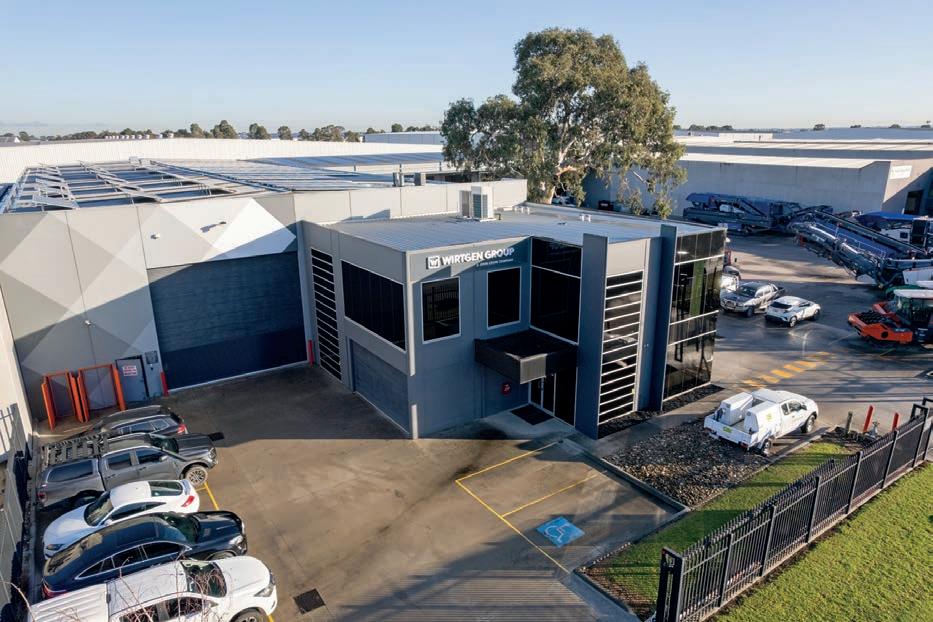
Images:
Wirtgen

“THE BIG GOAL FOR US IS TO FUNCTION ALMOST LIKE A FORMULA ONE TEAM. THAT IS TO PREDICT AS MUCH AS WE CAN WITH THE DATA WE HAVE, DIAGNOSE FAST, ACT FAST, AND RESPOND IN A WAY THAT LIMITS THE IMPACTS ON OUR CUSTOMER’S PRODUCTIVITY.”
Stuart Torpy, Managing Director –Wirtgen Australia says that thanks to the new facilities across both states, the days of over relying on the company’s Sydney warehouse for parts are over.

“These expansions mean our customers can be more confident in our capability and capacity to support their Wirtgen Group fleets through parts and servicing,” he says.
“The big goal for us is to function almost like a formula one team. That is to predict as much as we can with the data we have, diagnose fast, act fast, and respond in a way that limits the impacts on our customer’s productivity.”
As well as increased efficiency, the new facilities provide a boost to safety and space, with reduced congestion due to increased storage, while improving the ability to securely store machines on-site.
But it’s not just about real estate. Expanded technical support is happening in parallel. The result? Wirtgen’s customers are the ultimate beneficiaries.
“It’s very much – from both a local and an international perspective – a big investment in where we see the business going in the future, as well as how we would like to support our customers,” Torpy says.
“In many respects, investing when the market is giving us some breathing room is by far the better option.
“It enables us to be prepared, resourced and at the ready when that spare time disappears due to customer activity, rather than starting from behind and playing catch up. We see many companies in the sector downsizing.”
But this reduces the ability to serve customers both now and into the future. That is not what the Wirtgen Group is about, Torpy adds.
“We’re committed to investing and growing, even when the sector isn’t on the same trajectory,” he says.
“That’s because we’re here for the long term. We don’t run away from the challenge, our customers or our equipment, no matter what the economy is doing.
“We want to work smarter and provide a better service to our customers to enable them to get the best out of their Wirtgen Group equipment.”
Wirtgen’s new facility in Dandenong South, Victoria.
NO-DIG DOWN UNDER










BRING ON THE BELL
THE BELL MOTOR GRADER RANGE WILL BE HITTING AUSTRALIAN SHORES SOONER RATHER THAN LATER, WITH HITACHI CONSTRUCTION MACHINERY AUSTRALIA SET TO WELCOME DOMESTIC OPERATORS TO THE UNITS.


Production of the highly anticipated Bell Motor Grader range is planned to start in Q3 2025 for Stage Three engine regulated markets and Australia.
Designed to meet the evolving needs of the industry, the new machines will deliver high productivity and precision control with superior operator station ergonomics and visibility.
The Bell Motor Grader combines Bell Equipment’s 70 years of manufacturing heritage with Hitachi’s global distribution strength and technical support network.
David Gallina, Product Manager at Hitachi, says the team is thrilled to introduce the Bell Motor Grader to the Australian market.
“We’ve been keeping a close eye on the development of this product, and now that we’ve seen its real-world performance and reliability, we’re confident it will hit the
mark in Australia’s demanding conditions,” says Gallina.
“Our customers expect durability, precision, and low total cost of ownership – and the Bell Grader delivers across all three fronts.”
The Bell Motor Grader features a sealed slew ring for enhanced blade control and longevity.
Its parallelogram ripper ensures efficient ground penetration and superior material handling, making tough jobs easier.
Designed with improved visibility, the cab offers an unobstructed view of the moldboard and worksite, enhancing safety and accuracy.
Gallina says the Bell Grader has the ability to operate in tough, remote, and extreme applications: “We know our market, from civil contractors to mining
operations across Queensland, Western Australia, and beyond, and we believe the Bell Motor Grader is engineered for the long haul.
“The Bell Grader will thrive in the civil infrastructure industry, a space that requires strength, power and reliability. It’s a world-class machine, built with the operator in mind and backed by technology that sets a new standard in its category.”
The Bell Motor Grader range includes three base models – the G140, G160, and G200 – each offered in four or sixwheel drive.

From fine grading in road maintenance to bulk earthworks in heavy construction the range, Gallina says is designed to handle it all.
“With early integration of six-wheel drive,
Images:
Hitachi
These graders are designed for various applications, from light maintenance to heavy construction and bulk earthworks.
To ensure optimal strength, the Bell Grader Range is fitted with Cummins engines and ZF transmissions.

the design avoids compromises typically seen when AWD (all wheel drive) is added as an afterthought,” says Gallina.
“The traction and control delivered by the 6x6 units is a standout, especially in slippery or undulating terrain often found in rural and remote worksites here.”
The Bell Motor Grader range is fitted with Cummins engines and ZF transmissions.
A tried-and-true combination that Gallina says ensures long-term serviceability and parts availability across the country.
“These machines were built for uptime,” he says. “The engines are Stage Three-A certified and compatible with alternative fuels like Hydrotreated Vegetable Oil and B20 biodiesel– a blend of 20 per cent biodiesel and 80 per cent conventional petroleum diesel.
“This is a strong plus as the industry moves toward more sustainable operations. Stage Five versions will be available from early 2026, enabling our customers to meet environmental requirements aligned with specific contracts and their corporate sustainability goals.”
Known for their quiet operation, fuel efficiency, low maintenance and reliability, the Cummins engine is a force to be reckoned with.
The G140 runs a 6.7 litre Cummins with a ZF ERGOPOWER transmission.
The G160 and G200 models feature a powertrain configuration where a Cummins engine – in this case a nine-litre – is paired with ZF’s hydro-mechanical
cPOWER transmission. This setup is common in heavy-duty machinery where power and efficiency are required.
MINIMUM EFFORT REQUIRED
The Bell Motor grader has several lowmaintenance components. From a fully sealed slew ring circle to simplified diagnostics, the Bell Motor Grader emphasises low maintenance and easy daily operation.
The sealed circle eliminates the need for regular adjustments and ensures consistent grading quality, critical for reducing downtime in remote regions.
“These features allow for extended service intervals, while importantly maintaining consistent performance,” says Gallina.
Advanced diagnostics have also been incorporated into the machine to reduce the complexity of daily checks and servicing.
Below: The engines are Stage Three-A certified and compatible with alternative fuels.

Although the Bell Motor Grader has retained familiar controls and layouts, the range incorporates a range of advanced components and features.
Gallina says these are designed to help operators to improve productivity, accuracy, maintain costs, and deliver work efficiently.
“Grader operators are some of the most skilled in our industry, and also the most discerning,” says Gallina.
“That’s why Bell focused so heavily on achieving the right operating feel and ergonomics. Whether you’re using the antler controls or joysticks, this machine feels right.”
STRENGTH IN PARTNERS
As the exclusive distributor for Bell Equipment in Australia, Hitachi offers a comprehensive range of machinery for its customers.
Gallina says combining the strength of Hitachi excavators and wheel loaders with Bell’s articulated dump trucks has been a strong match from the beginning.
“It’s exciting to be part of a collaboration where a globally respected original equipment manufacturer like Bell has engineered something this good,” he says.
“We at Hitachi get to be the ones bringing it to Australian soil.
“We’re not just launching another grader – we’re introducing a new benchmark. And we can’t wait to show our customers what it can do.”




















The ALLU Asphalt Bucket is a hybrid screening solution designed for the on-site screening and crushing of asphalt.

TOTAL CRUSHING AND SCREENING
ALLU HAS LAUNCHED ITS ASPHALT BUCKET TO COMPLEMENT THE EXISTING ALLU SCREENER AND CRUSHER BUCKET RANGE.
ALLU, a global leader in screening and crushing bucket attachments, has released the Asphalt Screening bucket, set to transform asphalt recycling across the nation.
A powerful, hybrid screening solution, the bucket is purpose-built for on-site crushing and screening of cold-milled asphalt and reclaimed asphalt pavement (RAP), one of the world’s most recycled materials.
Despite this statistic, much of asphalt’s potential remains untapped due to inefficient processing methods.
The ALLU Asphalt Bucket helps to close this gap by turning milled material into a highquality resource on-site, supporting greener, leaner infrastructure development.
Manufactured in Finland, ALLU buckets are built for efficiency and durability, getting the job done in a faster, cleaner, and more costeffective way.
With distribution in over 30 countries, ALLU products are readily available across Australia through an authorised dealership network that also provides maintenance and support.
ALLU is a family-owned company known for innovative attachments that transform the way materials are processed and reused.
With decades of experience, ALLU provides advanced material processing solutions for earthmoving, mining, recycling, and industrial applications.
PROVEN SUCCESS
As municipalities, contractors, and asphalt producers look for smarter ways to reuse milled asphalt, the ALLU Asphalt Bucket delivers a transformative advantage.
One of those contractors is MRD Plant. Based in Leicestershire, England, the plant and machinery hire organisation provides nationwide services to the United Kingdom recycling, construction, quarrying and mining sectors.
After first trialling a second-hand ALLU screening bucket in its operations to recycle asphalt, MRD Plant quickly invested in three new models for its machinery fleet.
Tom Chapman, Managing Director of MRD Plant says the transformer buckets which can screen, crush, pulverize, mix, and separate a wide range of materials are ideal for daily operations.
“In many cases, the Asphalt Bucket has proven to be much more efficient, productive, and less expensive than transporting a mobile crushing plant to the work site,” says Chapman.
“At a time when efficiency, sustainability, and profitability are key, the Asphalt Bucket ticks all the boxes”.
The Asphalt Bucket utilises a hybrid blade configuration – a mix of screening and crushing blades – to fine-tune performance and achieve consistently high-quality end products.
Using the machine’s hydraulic system, the Asphalt Bucket attachment converts the excavator or loading shovel into a mobile processing plant to process materials which can be wet and/or dirty.
With interchangeable blades and spacings ranging in size, operators can adjust the

Asphalt Bucket to meet the requirements needed on their job site.
Although the Asphalt Bucket is primarily used for asphalt, the attachment also has the capacity to screen and separate various other materials,
These include different soil types, sand, gravel, topsoil, compost, demolition waste, biomass, processing and more.
The Asphalt Bucket is available in several sizes for 25-45 tonne excavators and 15-30 tonne wheel loaders.
Its design includes a serrated cutting edge and reinforced frame, tailored specifically for asphalt processing.
Whether it’s pre-crushed demolition asphalt or compacted cold-milled material, the Asphalt Bucket is engineered for reliability, mobility, and productivity – even in tight or urban work sites.
Models can deliver up to 250 tonnes per hour, with rapid drum change-outs thanks to its Variable Drum technology.
The ALLU Variable Drum is a new drum structure with a rapid blade change
“THE HYBRID BLADE SETUP IS WHAT MAKES THIS BUCKET SO EFFECTIVE – IT DELIVERS JUST THE RIGHT MIX OF CRUSHING FORCE AND FINE SCREENING TO PROCESS ASPHALT EFFICIENTLY IN A SINGLE STEP.”
mechanism, designed to streamline operations and boost productivity.
With nominal screen sizes of 12, 16, and 25 millimetres, the bucket can produce over 95 per cent of finished material below target size, drastically reducing reprocessing needs.
Peter Grönholm, Chief Executive Officer of ALLU Finland Oy, says the Asphalt Bucket is a one-stop operation as it crushes and screens cold-milled asphalt simultaneously, eliminating the need for separate precrushing or secondary equipment.
“The Asphalt Bucket reduces reliance on mobile impact crushers and therefore cuts fuel consumption and parts expenses,” he says. “The hybrid blade setup is what makes this bucket so effective. It delivers the right mix of crushing force and fine screening to process asphalt in a single step.”
Grönholm says there has been a clear shift globally toward sustainable infrastructure in construction business.
“Asphalt recycling plays a major role in this movement, and our new Asphalt Bucket empowers contractors to turn reclaimed and cold-milled asphalt into high-quality, reusable material, directly on site,” he says.
“It’s a smarter, more profitable way to work, and we’re proud to help drive this transformation across the industry.”
The Asphalt Bucket will be available in Australia Q4 2025 across ALLU dealerships. This includes QLD Rock Breakers for Queensland and Northern Territory residents, Walkers Hammers for Victorian, South Australian and Tasmanian residents and Total Rockbreaking Solutions for Western Australians.
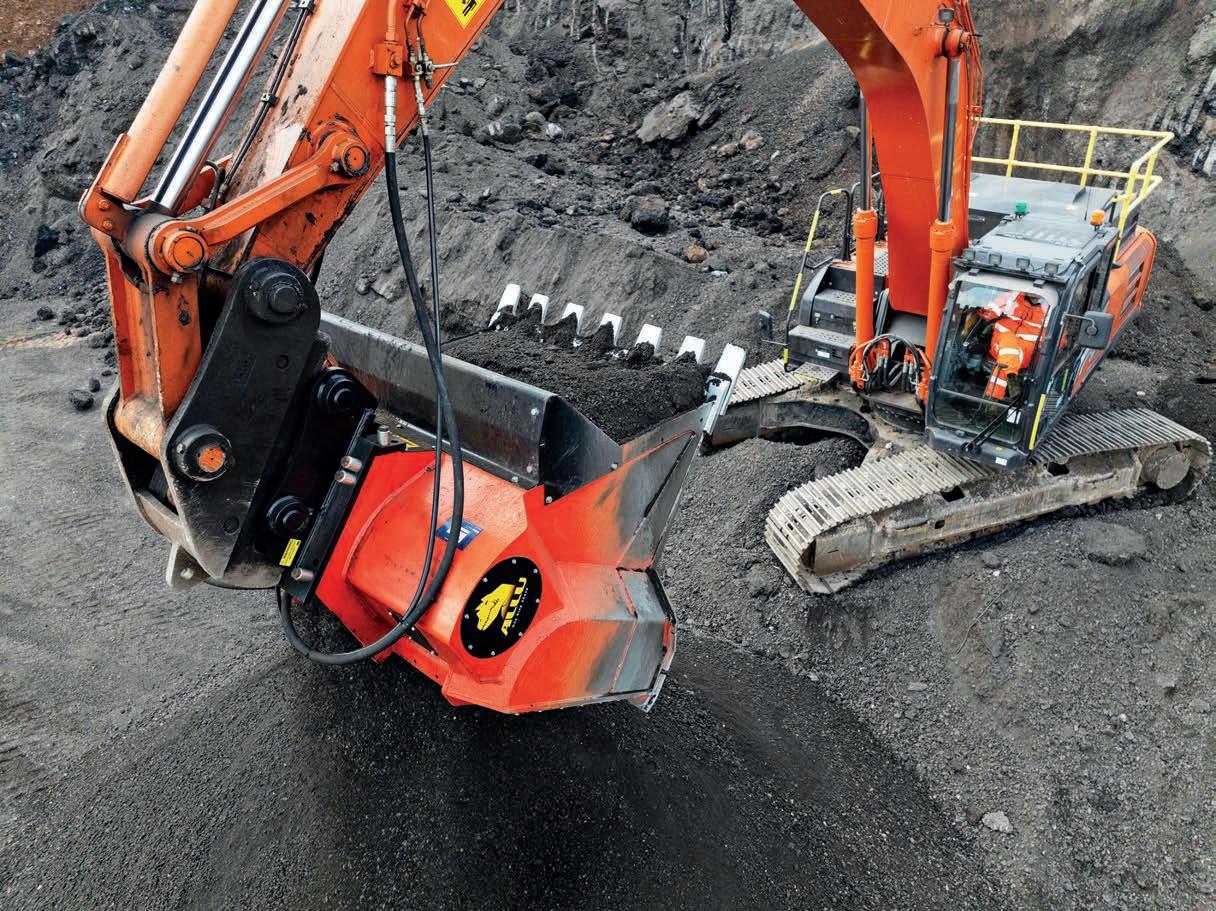
The bucket has nominal screen sizes of 12, 16, and 25 millimetres.

FROM CLOTHING TO
CONCRETE
A NEW TRIAL FROM VICTORIA UNIVERSITY IS EVALUATING THE POTENTIAL INCLUSION OF RECYCLED HIGH-VISIBILITY VESTS TO CREATE SUSTAINABLE CONCRETE. MALINDU SANDANAYAKE, VICTORIA UNIVERSITY ASSOCIATE PROFESSOR, BUILT ENVIRONMENT – COLLEGE OF SPORT, HEALTH AND ENGINEERING EXPLAINS.
In Australia, more than 200,000 tonnes of clothing are discarded and sent to landfill every year, according to The Australia Institute. That’s close to four times the weight of the Sydney Harbour bridge.
Fast fashion and general clothing waste continues to be a significant issue globally. Despite no direct links or correlation between textile waste and the construction sector, recent collaborations have reflected an interest in solving this growing issue.
The original spark came from Assembled Threads, a social enterprise that helps unemployed and disadvantaged individuals by providing training and employment in the garment manufacturing space.
Assembled Threads identified an under-reported, but growing issue – the rising number of high-visibility (high-vis) construction vests that were ending up in landfill.
The organisation approached Victoria University hoping to create a more sustainable and efficient disposal pathway once high-vis vests had reached the end of their serviceable life. (These vests are typically discarded after about 20 to 25 washes.)
Malindu Sandanayake, Victoria University Associate Professor, Built Environment –College of Sport, Health and Engineering says initial interest was high. The first step was to evaluate what was possible.
“We started doing some initial experiments with a few vests that had been used. We were seeking a microscopic view of the fibres to investigate the micro-structure,” he says. “It was all about understanding how these fibres behaved, as well as the temperature at which the vests started to melt.”
After a TGA (Thermogravimetric) analysis, which also helped to determine the point at which the fibres would degrade, and whether they could maintain structural integrity in concrete, the research team sought a research and development grant from Sustainability Victoria.
INDUSTRY SUPPORT
The joint ‘Towards Circular High Visibility Apparel’ project received funding from Sustainability Victoria’s ‘Circular Economy Markets Fund: Materials’ scheme to support further research. The goal: To combine textile waste from the high-vis vests and
cardboard waste to develop a blended composite material, which could then act as an alternative to components in virgin cement.
Victoria University and Assembled Threads coined this material ‘tex-crete’.
Sandanayake says the development of tex-crete represents a shift, not only in what the construction sector believes is possible, but also how the industry looks and thinks about sustainability.
“It’s about trying to find new ways to use valued materials,” he says. “That means not only are we solving the waste problem of what’s going into the landfills but we’re also trying to address those issues of the energy-intensive extraction of raw materials, while addressing the scarcity of raw material.
“We thought about the textile synthetic fibres that the recycled material exhibits and its potential to bond concrete together. So why not use it as a fibre reinforcement inside the concrete?
“That was a big benchmark for us, whether or not it could be used to reduce the number of reinforcement steel that’s used in concrete.”
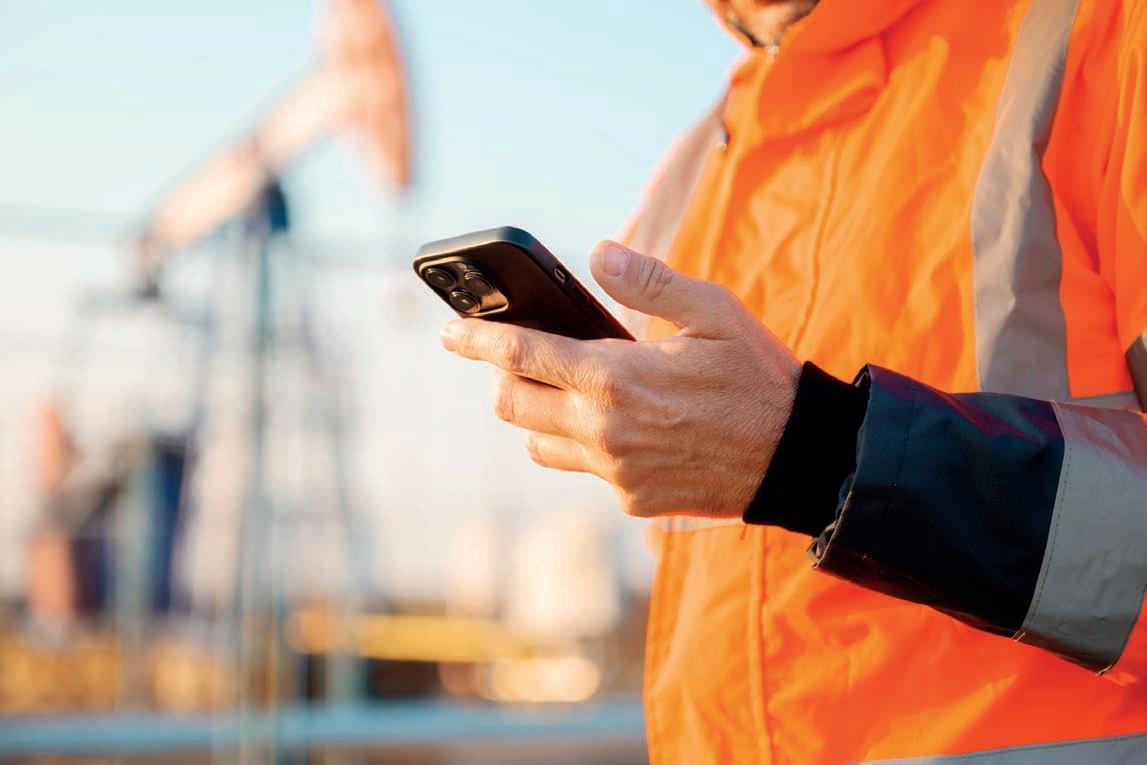
Sandanayake, Victoria University Associate Professor, Built Environment –College of Sport, Health and Engineering.

Sandanayake says one of tex-crete’s biggest exhibited benefits throughout testing has been its superior performance in compressive, tensile and flexural tests, all fundamental assessments used to evaluate the capability of a material under load.
In particular, tex-crete has displayed improved durability, being more resistant to longitudinal cracking compared to standard concrete. The sustainable material also shows reduced crack propagation, a condition that would normally see a crack extend through the full length of the material.
The application of such a material could result in more durable car parks, walkways and footpaths, also helping to reduce repair costs.
“It’s helping to solve multiple problems that contribute to economic development, environmental savings, and community development,” Sandanayake says.
“Sustainable outcomes tend to contribute to the wider community. By creating opportunities for construction companies, textile producers and social enterprises, we’re providing holistic advantages across the supply chain and to a wider stakeholder group.”
And no, the concrete does not glow in the dark. While high-vis components are
visible during initial pouring and setting, the appearance becomes indistinguishable from standard concrete upon drying. It’s also got a similar texture.
BROADENING BENEFITS
Concrete mix designs are currently being tested at both 25 and 32 MPa (megapascal, measure of compressive strength), with initial monitoring of performance over multiple months now complete. Additional monitoring will take place over the next year to evaluate longer-term durability and performance.
Excitingly, signs are pointing towards the potential for including a wider range and variety of clothing types in the mix.
According to Sandanayake, most clothing products that exhibit and contain textile properties could be a good fit for recycling in the future, opening the door for more sustainable pathways and further landfill volume reductions.
“Any synthetic fibre, where the life cycle is really high, takes a lot of time to decay,” he says. “Any synthetic fibres extracted from any kind of textile should be able to work.”
For Sandanayake and the team – consisting of Ehsan Yaghoubi, Paul Joseph, Zora Vrcelj, Robert Haigh and Manish Bhusal – the next steps present the biggest challenges, but they are eagerly embracing each test.

“The next big step, once research and development has concluded, is working towards commercialisation. That will coincide with performance optimisation, refining the fibre size and composition and further improving the concrete mix design,” he says.
“We plan to work parallelly on both of these aspects. We then should have a clear idea on how we plan to move forward.”
Commercialising tex-crete will be aided by collaboration with concrete manufacturers, helping to understand production challenges, as well as supply chain opportunities.
Sandanayake says while there are a few years to go, excitement is already high internally when discovering potential future applications for a development that could not only transform sustainability in the clothing sector, but also potentially reinvent traditional methods and practices for construction materials.
“What really excites me is turning this research into practice and watching our findings translate into real life products or processes,” he says. “At the end of the day, the community will reap the benefits.”
Malindu
Image: Victoria University
The
EVERYDAY CLAY
THE ANSWER
THE PERFORMANCE OF LOW-GRADE CLAY AS AN ALTERNATIVE AND SUSTAINABLE SUBSTITUTE TO CEMENT IN CONCRETE PRODUCTION, IS BEING ASSESSED AS PART OF NEW RESEARCH BY RMIT UNIVERSITY. LEADING RESEARCHER DR CHAMILA GUNASEKARA DISCUSSES THE PROGRESS MADE SO FAR.
Multiple challenges continue to provide barriers to the widespread adoption of sustainable methods and materials.
Underdeveloped markets, costs and adaption required are just some of the reasons why sustainability is still a growing aspect of construction and infrastructure projects, instead of a mainstay.
Cement production is just one example of a regular industry activity that’s extremely carbon intensive. But what if a sustainable solution was right under our feet?
Led by Dr Chamila Gunasekara, engineers from RMIT University have endeavoured to answer this question. As Gunasekara explains.
“Cement production generates around 0.8 to one tonne of CO2 (carbon dioxide) per tonne of cement, contributing about seven to eight per cent of CO2 emissions globally,” he says.
“The cement industry is facing huge challenges when it comes to upcoming net zero targets. The need for continued cement production means that we need to find an alternative, to reduce overall carbon emissions.”
To reduce the carbon intensity of cement production, the research team started to assess material substitution.
There were concerns about the availability of alternatives such as slag and fly ash, encouraging the team to look at other potential solutions. One material that garnered traction was clay.
Clay is already widely used as a construction material, commonly found in bricks, tiles, and other structural elements such as walls or drainage pipes. In fact, it’s been used for thousands of years in construction applications.
Gunasekara notes that previous research has evaluated similar possibilities. Where this research differs is the quality, and therefore


“WE WANTED TO SEE AND ASK, ‘WHY CAN’T WE USE MIXED, WIDELY AVAILABLE CLAY TYPES, INSTEAD OF JUST THE HIGH-GRADE KAOLIN CLAY?’ IT WAS ALL ABOUT SEEING WHETHER OR NOT WE COULD ACTIVATE AND USE A SECONDARY OR SUPPLEMENTARY CEMENTING MATERIAL.”
availability of the chosen materials. As he explains.
“Earlier research has focused on highgrade kaolin clay, an expensive and scarce type that’s also in high demand from the ceramics and paper industries,” Gunasekara says.
“We wanted to see and ask, ‘why can’t we use mixed, widely available clay types, instead of just the high-grade kaolin clay?’ It was all about seeing whether or not we could activate and use a secondary or supplementary cementing material.”
Illite, another clay variant, is much cheaper
and more available – key factors that led to its selection as the principal material for this research project.
The research team set out to see how a mixture combining illite and low-grade kaolin clay would perform as a substitute.
One of the first challenges that the research team encountered was that lowgrade illite clay does not normally bind well with cement and water.
Initial testing found that the joint heating, or co-calcination process greatly enhanced the illite clay’s binding ability. In particular, testing involved mixing both clay types at
The combined clay mix after being heattreated, ready for use as a cement supplement.
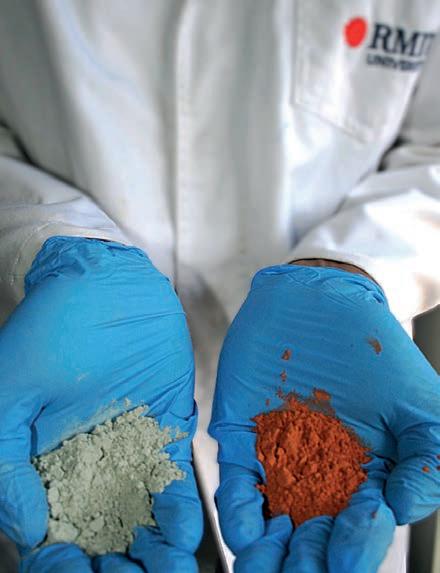
an equal ratio, before heating the mixture at 600 degrees Celsius.
The results were largely positive, with the mixture exhibiting several performance improvements. The mixture was used to replace 20 per cent of the cementitious material, showing greater strength, durability as well as water retention.
The manufacturing process also proved to be more energy and cost efficient.
Studies ultimately found that the illitekaolin clay mixture could match – and in some cases even surpass – the performance of traditional kaolin-based substitutes.
With demand for kaolin steadily on the rise – the market is projected to grow to



US$6 billion by 2032 – the research team is hoping that this project could provide a major boost for the illite clay market.
NEXT STEPS
With initial testing providing positive insights into potential performance, the research team is now gearing up for further evaluations, specifically concrete performance testing, as well as additional structural and durability testing.
The team will also be exploring mechanochemical activation techniques, in other words, using mechanical energy to modify and hopefully improve material properties.

The ultimate goal is the examination of performance over extended periods.
This research, as well as previous projects have been supported by the ARC Industrial Transformation Research Hub for Transformation of Reclaimed Waste Resources to Engineered Materials and Solutions for a Circular Economy (TREMS).
Led by RMIT’s Professor Sujeeva Setunge, TREMS brings together top scientists and industry experts from nine Australian universities and 36 state, industry, and international partners to minimise waste and repurpose reclaimed materials for the construction sector.
Findings and research have been – and continue to be – shared across these different research facilities, providing additional resources to a wealth of expertise, all driven towards a common goal.
Such a project highlights the need for greater collaboration and partnership to develop industry-wide improvements and benefits, Gunasekara says.
“As researchers, we can conduct trials and testing, we can do the work, but we can’t translate that into real applications and action without industry support,” he says.
“That’s why we’re trying to get the message out there that we need such support to transition this material into the field. We don’t want to duplicate or reinvent the wheel. That’s the advantage and purpose of this collaboration, so we can work to our strengths, and our partners and industry can work to theirs, to deliver the best possible outcome.”
Dr Roshan Jayathilakage, Dr Chamila Gunasekara, Dr David Law, Associate Professor Dilan Robert, Professor Sujeeva Setunge, Dr Yuguo Yu.
RMIT is hoping that the project will create new possibilities and markets for what is an increasingly sustainable option.
Dr Chamila Gunasekara holds a sample of one of the team’s low carbon concrete blends.

SYDNEY GATEWAY: PRECISION PRECAST POWERS A PIVOTAL TRANSPORT LINK
THE SYDNEY GATEWAY PROJECT REPRESENTS A DEFINING STEP FORWARD IN MODERNISING SYDNEY’S TRANSPORT
INFRASTRUCTURE, AS WELL AS YET ANOTHER EXAMPLE OF THE EFFECTIVENESS AND HIGH-QUALITY OUTCOMES PROVIDED BY PRECAST ELEMENTS.
Designed to streamline the connection between Sydney’s motorway network and its international airport, the Sydney Gateway project is expected to dramatically reduce congestion, improve travel times and enhance quality of life for the thousands who commute through the precinct daily.
Delivered by the Seymour Whyte–John Holland joint venture, the project demanded seamless integration with existing road and rail systems, calling for tight deadlines, adaptability and minimal disruption to daily operations in one of Australia’s busiest transport corridors.
COMPLEX SCOPE, DEMANDING CONDITIONS
A key contributor to this monumental build was National Precast member Ozcast, engaged to manufacture and supply a combination of precast shells, traffic barriers and parapets. Spanning from September 2022 to March 2024, the contract was significant in both volume and complexity.
The most technically challenging element involved the manufacture of 121 uniquely specified precast shells. Each shell required tailored moulds and processes, with no opportunity for mass production efficiency. Adding further complexity was the strict sixmonth installation window. This was essential to avoid cascading delays across surrounding works, which could have extended the overall timeline by up to a year.
In contrast, the production of more than 1400 traffic barriers and parapets

PROJECT SNAPSHOT
PROJECT: Sydney Gateway
LOCATION: Sydney, NSW
NATIONAL PRECAST MEMBER: Ozcast
CLIENT: Seymour Whyte–John Holland Joint Venture
allowed Ozcast to apply volume-based efficiencies. Its well-honed production systems and quality controls enabled rapid output without compromising on durability or precision.
A SINGLE SOURCE OF TRUTH
With shifting timelines, evolving site requirements and a multitude of stakeholders, clear communication was vital. To streamline collaboration, the joint venture established a single point of contact for Ozcast, ensuring consistent communication and fast decision-making.
“Ongoing contact with a dedicated project lead allowed us to remain agile, maintain progress and adapt in real-
time,” says Ozcast Precast Manager, Barry Lindsay. “It was a key factor in delivering critical components on time and to specification.”
This approach underscored the project’s broader theme: when coordination, clarity and technical expertise come together, large-scale infrastructure projects can meet even the most rigid timelines.
BUILT FOR THE PRESENT, PREPARED FOR THE FUTURE
The successful delivery of the Sydney Gateway’s precast components further demonstrates Ozcast’s capability to handle both high-precision and high-
The Sydney Gateway project is set to provide major benefits for a large volume of motorists who take the project route daily.

“OZCAST EXEMPLIFIES WHAT IT MEANS TO BE A NATIONAL PRECAST MEMBER – RELIABLE, PRECISE AND SOLUTIONFOCUSED.
volume orders under pressure. Its work not only supported the project’s delivery targets but also contributed to a safer, more sustainable transport future for Sydney.
“Precast offered clear advantages for the Sydney Gateway,” says National Precast Chief Executive Officer Sarah Bachmann. “From speed of production to quality assurance, the off-site manufacture of key components ensured construction could progress smoothly, even in one of Australia’s most logistically challenging areas.
“Ozcast exemplifies what it means to be a National Precast member – reliable, precise and solution-focused. Their contribution to the Sydney Gateway will serve as a benchmark for future infrastructure delivery.”

HIGH STAKES, HIGH STANDARDS – OZCAST DELIVERS UNDER PRESSURE
Tasked with delivering 121 custom precast shells and over 1400 barriers and parapets, National Precast member Ozcast rose to the challenge with agility and expertise. The company’s ability to balance precision and scale under intense deadline pressure solidified its role as a trusted partner in one of Sydney’s most significant infrastructure upgrades.
Images: National Precast
National Precast member Ozcast carried out significant works on the project.
The project will help to futureproof the surrounding road network across the region.
BEYOND HARD HATS: SYSTEMIC SOLUTIONS FOR ROAD WORKER SAFETY
THE AUSTRALIAN FLEXIBLE PAVEMENT ASSOCIATION IS RETHINKING HOW PROCUREMENT AND STRATEGIC FUNDING CAN TRANSFORM SAFETY OUTCOMES, AS MARK PIORKOWSKI, EXECUTIVE DIRECTOR OF QLD AND NT AND CONVENOR OF AFPA’S NATIONAL HEALTH AND SAFETY COMMITTEE, WRITES.
The construction industry has long approached safety through familiar pathways: enhanced training programs, advanced warning systems, and better separation between workers and hazards.
These measures are, and will always remain crucial, having undoubtedly saved lives. They represent responses to mitigation of identified risks, and are fundamental to planning and implementing safety practices on construction sites. However, as road worker fatalities continue across Australia, it’s time to ask whether we’re leveraging the full spectrum of system-level levers to keep workers safe, and consider other structural prevention strategies.
REACTIVE TO SYSTEMIC THINKING
The Australian Flexible Pavement Association (AfPA), in collaboration with industry stakeholders including Roads Australia (RA), the Traffic Management Association of Australia (TMAA), and Austroads, continues to drive practical safety innovations.
These include training programs for workers on foot, smart enforcement tools like Queensland’s Roadways Behaviour Monitoring System (RBMS), and growing incident awareness initiatives.
The RBMS pilot – trialled on the Pacific Motorway in late 2022 – demonstrated measurable improvements in driver behaviour. Workers reported feeling safer, while data showed real-time reductions in vehicle speeds as the camera system appeared on traffic apps. These improvements are powerful – but they also underscore the need to look beyond the worksite toward the procurement, funding, and regulatory systems shaping safety outcomes from the top down.
THE PROCUREMENT BLIND SPOT
A critical barrier to safety innovation lies in how infrastructure is procured. Current models often bundle safety costs within overall bid prices, making above-minimum safety investments commercially disadvantageous. Companies have expressed frustration: enhanced safety, while supported in principle, can weaken bid competitiveness in practice.
This is not a matter of lacking commitment. Instead, it’s a structural flaw. Fixing it doesn’t require more regulation; it requires smarter procurement and evaluation practices. Separating safety submissions from project cost assessments and evaluating them “below the line” would allow contractors to propose safety innovations without commercial penalty. This model would align incentives between clients and suppliers, position safety innovation as a value differentiator and avoid penalising contractors for going above compliance. This approach is also the subject of a recent joint industry letter to government, signed by AfPA and peer organisations, which proposes evaluating safety investments separately from overall project costs. By removing commercial penalties for going above minimum standards, the model empowers contractors to propose their best safety innovations.
Roads Australia’s FY25 Road Worker Safety Action Plan reinforces this shift, calling for independent evaluation of safety components and direct engagement with Chief Procurement Officers. The message is clear: safety must be baked into project value, not bolted on.
STRATEGY IN NAME, NOT YET IN NATURE
The National Road Safety Strategy 2021-30 outlines a Safe System approach that recognises workers on foot as vulnerable road users, placing them alongside pedestrians, cyclists, and riders. It promotes infrastructure separation, Movement and Place design, and speed enforcement to reduce harm.
Yet despite adopting a social model of road safety – one that distributes responsibility across government, industry, and the broader community –the strategy stops short of translating

this into targeted protections for those working in live traffic environments. Road workers may be acknowledged as vulnerable, but they remain under-protected in planning and funding frameworks.
AfPA continues to advocate for better integration of worker safety within these frameworks, working with stakeholders across the sector to progress this dialogue into concrete action.
DATA: THE MISSING LINK
A foundational barrier to reform remains the lack of comprehensive national data on road worker safety incidents. While fatalities are recorded through jurisdictional processes, serious injuries, near misses and lower-severity incidents are often inconsistently captured, if at all.
This limits our ability to identify trends, shape investment, and build compelling business cases for change.
AfPA, working closely with TMAA and others, is championing the creation of national data protocols that include both incidents and high-risk scenarios. This creates a leading indicator framework, one that moves beyond
lagging trauma data to proactively shape safety interventions. This priority is also echoed in the RA Action Plan, which calls for the collection of real-world examples from high-risk sites and a national safety reporting culture.
Together, these efforts can form the evidence base needed for targeted reform.
TOWARD A SAFER SYSTEM
The solution is not to replace current safety measures, instead it’s to systematise them.
That means procurement reform, the evaluation of safety business cases independently in tenders, as well as ensuring that innovation isn’t commercially penalised. It also requires funding alignment, by embedding safety performance metrics into federally funded infrastructure programs to reward excellence, not just compliance.
Standards and training should also be a focus to support national harmonisation through Austroads’ initiatives, while lifting capability across traffic management providers.
Lastly, data infrastructure would help to build a sector-wide learning system
informed by rigorous reporting, enabling proactive and evidence-based action.
Each of these is reflected in AfPA’s current strategic agenda. We continue to actively seek collaboration with industry partners and other organisations who share our commitment to safer outcomes.
The shared goal is clear: transform road worker safety from a site-level program into a system-wide imperative.
The flexible pavement industry has never lacked commitment to worker safety. Those who plan, build and maintain Australia’s road surfaces carry a deep, ongoing responsibility to protect their crews.
But commitment alone won’t overcome systemic barriers that make safety innovation commercially risky or sideline data-informed decision-making.
AfPA stands ready as a convener, a policy advocate, and a delivery partner to help make road worker safety a competitive advantage, not a cost to be contained. By reforming procurement, linking funding to performance, and embedding robust national data systems, we can rewrite the rules of the game and ensure that safety excellence is not the exception, but the standard.


The Australian Flexible Pavement Association has outlined the importance of greater practical safety innovations.


COUNTING DOWN TO CONEXPOCON/AGG
CONEXPO-CON/AGG HAS UNVEILED ITS EXPANDED ‘NEXT LEVEL’ AWARDS AND NEW EXHIBIT DESIGN AWARDS FOR 2026.
CONEXPO-CON/AGG, recognised as North America’s top construction trade show is less than one year away from delivering an expansive and innovative experience for the global construction industry.
Returning to Las Vegas from March 3-7, 2026, CONEXPO-CON/AGG will bring together tens of thousands of professionals, exhibitors, and industry leaders from around the world.
Held every three years, CONEXPOCON/AGG is a must-attend event for construction industry professionals.
The show features the latest equipment, products, services and technologies for the construction industry, as well as education.
CONEXPO-CON/AGG is owned in partnership with National Ready Mixed Concrete Association (NRMCA), National Stone, Sand & Gravel Association
(NSSGA) and Association of Equipment Manufacturers (AEM).
To follow on from the record-breaking success of CONEXPO-CON/AGG 2023, organisers have expanded the Next Level Awards for 2026 by introducing two new categories: Equipment and Technology.
This program, which debuted at the 2023 event, celebrates companies that push the boundaries of innovation in the construction industry.
Nominations for the awards open August 19, 2025, and close on December 1, 2025.
A panel of industry specialists who are yet to be announced will shortlist 10 outstanding entries per category.
Attendees at the event will have the opportunity to vote for their favourite finalists, with the winners to be revealed on the “Groundbreakers” keynote stage on Friday, March 6.
Dana Wuesthoff, Show Director of CONEXPO-CON/AGG, says the expansion of the Next Level Awards exemplifies the event’s commitment to advancing the construction industry.
“The introduction of the Equipment and Technology categories is a testament to CONEXPO-CON/AGG’s dedication to recognising the full spectrum of innovation within the construction industry,” she says.
“This expansion allows us to celebrate the groundbreaking solutions that are transforming construction practices.
“These categories highlight the ingenuity and forward-thinking approaches that are essential for the industry’s evolution.”
Wuesthoff says the new categories recognise the role that advanced machinery and cutting-edge technologies play in enhancing efficiency, safety, and sustainability in construction projects.
CONEXPO-CON/AGG 2023 was the last time attendees gathered in Las Vegas for North America’s top construction trade show.


There will be over 2000 exhibitors and 150 sessions at the March 2026 event.
“If we can elevate and celebrate the groundbreaking innovations that have an enormous impact on how we build our world, the awards will offer a remarkable opportunity for companies to gain recognition and visibility for their innovative contributions,” she says.
“By highlighting the most inventive products, services, and technologies, we not only honour the pioneers driving progress but also inspire the entire industry to reach new heights.”
Selected finalists will be highlighted in CONEXPO-CON/AGG press releases, social media platforms, and other
relevant outlets, encouraging attendees to visit their booths and discover their groundbreaking products.
EXHIBIT DESIGN AWARDS
In addition to the Next Level Awards, CONEXPO/CON-AGG 2026 will feature the Exhibit Design Awards, managed by EXHIBITOR Magazine.
This program will honour exhibitors for their exceptional booth design efforts.
All displays at the event will be automatically entered into the competition and sorted according to size.
The team at EXHIBITOR magazine will complete the initial round of unbiased judging, identifying up to ten finalists in each category.

These finalists will be assessed on-site by a panel of designers and marketers, who will choose a winner for each category and an “Editor’s Choice” award recipient.
The announcement of the winners will take place on the Groundbreakers Stage, with recipients receiving a trophy and a scholarship to attend EXHIBITORLIVE 2026.
This accolade not only acknowledges the ingenuity and effort in booth designs but also aims to inspire the
entire industry with innovative and influential presentations.
Wuesthoff says the Exhibit Design Awards offer a unique opportunity for exhibitors to gain recognition for their creativity and innovation in booth design.
“By celebrating outstanding displays, we encourage participants to push the boundaries of experiential design and create memorable experiences for attendees,” she says.
“Partnering with EXHIBITOR Magazine for the CONEXPO/CON-AGG 2026 Exhibit Design Awards allows us to leverage their expertise in recognising exceptional trade show designs.
“This collaboration ensures that the most innovative and impactful presentations are celebrated, setting a high standard for future events.”
Emily Olson, editor of EXHIBITOR magazine, says for more than 30 years, EXHIBITOR has recognised compelling and effective trade show design.
“Working with an event that prioritises innovation in exhibit and experiential design is a natural fit,” says Olson.
“Our editorial team and panel of expert judges are eager to see the creativity CONEXPO-CON/AGG participants will unveil in 2026.”
Below: Holcim accepted the Next Level Awards Contractors’ Choice Award during the 2023 CONEXPO-CON/AGG.
REAL SOLUTIONS FOR AUSTRALIA’S TRANSPORT FUTURE
HIGHWAYS AU, AUSTRALIA’S FLAGSHIP EVENT FOR ROADS, TRANSPORT, AND MOBILITY, RETURNS TO SYDNEY THIS OCTOBER.
Held at the International Convention Centre from 15 to 16 October, Highways AU will bring together hundreds of professionals from across industry and government to explore the future of road infrastructure and transport systems.
From policy to procurement, safety to sustainability, the program is built around practical insights and strategies to help decision-makers deliver better outcomes on the ground.
WHAT CAN YOU EXPECT?
The 2025 program focuses on innovation, collaboration, and long-term thinking, offering more than 150 sessions across key themes including asset management, digital delivery, local government leadership, parking infrastructure, sustainability, and smarter project delivery.
Sessions will run across the following key areas: asset maintenance and materials, smart cities and local government, construction and delivery, connected highways and Intelligent Transportation Systems (ITS), parking and precinct planning, sustainability and circular economy, as well as fleet and transport logistics.
PROGRAM HIGHLIGHTS
The conference opens with a keynote session on the future of mobility, followed by a feature presentation on the world’s longest immersed tunnel, a major international project demonstrating
innovation at scale. A strong focus on safety runs across the Connected Highways and ITS stream, with panel sessions exploring how policy, infrastructure and local engagement are working together to reduce road trauma.
Another key topic is how traffic management can be improved through smart technologies and sustainable approaches.
In the construction stream, delegates will hear how digital delivery is transforming the way infrastructure is designed, built and managed.
Sessions will explore how digital engineering, automation and smarter procurement are helping projects stay on track, particularly in an environment of rising costs and growing demand.
SUPPORTING COUNCILS AND COMMUNITIES
A series of local government-focused sessions will look at practical strategies for safer streets, greener cities, and more connected communities. From enhancing local roads to enabling active transport, this stream highlights the role councils play in delivering critical infrastructure close to home.
Parking is also firmly on the agenda, with sessions exploring its role in traffic flow, safety, economic activity and local government planning.
Panels will cover how councils are approaching parking infrastructure and how new technologies are changing how kerbside space is used.

SMART ASSET MANAGEMENT AND
FUTURE-READY
NETWORKS
The asset management stream provides a deep dive into technologies and strategies to extend road life and reduce whole-of-life costs. Panels will discuss new approaches to condition assessment, performance modelling and technology integration.
Other sessions will explore how to build climate resilience into road design, enhance maintenance planning, and adopt more sustainable materials and methods. Flood recovery and the growing need for infrastructure adaptation will also feature.
SUSTAINABILITY AND CIRCULAR THINKING
Sessions in the sustainability stream will explore how transport infrastructure can meet long-term environmental and economic goals. Topics include circular economy strategies, materials reuse, and climate-smart asset design. These sessions offer practical guidance on embedding sustainability in day-to-day project planning and delivery.
WHY ATTEND?
Highways AU 2025 is a chance to connect with industry leaders, hear first-hand from peers delivering complex projects, and get practical guidance you can take back to your organisation.
Whether you’re in government, construction, engineering, planning or asset management, this event offers insights to help you navigate challenges, deliver better outcomes and shape transport networks that are safer, smarter and more sustainable.
DON’T MISS OUT
Registrations are free and now open for Highways AU 2025. Join the conversation, connect with industry, and be part of the event shaping the future of Australia’s transport infrastructure.
Left: Highway AU combines the best of the transport and construction sectors, showing what’s available now, as well as what’s to come.




































































TRAILBLAZERS GALORE
The 2025 Women in Industry Awards highlighted the fantastic work being done by women in often maledominated industries.



ROADS & INFRASTRUCTURE MAGAZINE BREAKS DOWN THE LATEST ITERATION OF THE WOMEN IN INDUSTRY AWARDS, WHICH RECOGNISED AND CELEBRATED TRAILBLAZERS FROM THE CONSTRUCTION AND TRANSPORT INDUSTRIES.

Held on Thursday 19 June at The Carousel in Melbourne, the 2025 Women in Industry Awards again honoured the efforts and achievements of individuals driving change in their chosen sector.
Prime Creative Media Chief Executive Officer Christine Clancy says the awards continue to play a vital role in recognising the achievements of women who are breaking down barriers and paving the way for future generations.
“These awards celebrate not only technical excellence but also the courage, resilience and leadership it takes to create lasting impact. Each winner is an inspiration and a powerful reminder of what’s possible when diversity is
embraced,” Clancy says.
The roads, transport and construction sectors were well represented at the awards, with a number of winners and nominees from these segments, reflecting the industry’s growing contribution from the next generation of female leaders.
EXCELLENCE IN CONSTRUCTION
The Excellence in Construction award was presented to Isolde Piet, of Suburban Connect. Piet was the first ever female tunnel boring machine (TBM) operator in the world more than 20 years ago, and has since inspired an entire generation of female infrastructure leaders.
Piet is now also leading the world’s first all-female TBM crew, one of eight
crews that will dig the 16-kilometre twin tunnels on the Suburban Rail Loop’s southern section in Melbourne. This crew has attracted more than 900 applicants, reflecting the strong interest and potential for greater female and minority representation on major infrastructure works.
Piet will oversee a comprehensive training program for the all-women TBM crew members, which will ensure they are ready to start tunnelling together in 2027. The all-women crew will include up to 25 roles, ranging from TBM operator, gantry and segment crane operators, to a range of support roles.
Piet’s trailblazing career has taken her across the globe, working in the Netherlands, Turkey and now Australia, all the while setting the example for the next generation of women looking to pursue a career in the construction industry.
EXCELLENCE IN TRANSPORT
Kirryn Crossman took out the Excellence in Transport award, in recognition of her great work with SMEC, a trusted partner on major transport and energy infrastructure projects across the globe.
The award aims to recognise an individual who has gone above and beyond to improve and positively impact the Australian transport industry. Crossman has done just that, and so much more.
The current Manager – Roads and Highways at SMEC’s Gold Coast office, Crossman has more than 16 years’ experience in the delivery of complex infrastructure projects. This includes works across Queensland, New South Wales, as well as the Australian Capital Territory, with projects such as road upgrades, urban developments and stormwater drainage.
Crossman’s commitment to diversity and skills development is equally strong. She spearheads a growing Women in STEM (Science, Technology, Engineering, and Mathematics) network on the Gold Coast, with a particular focus on supporting young women in engineering.
Her outreach has directly enabled six female students to transition from university into engineering roles by connecting them with industry through site tours, mentoring, and career coaching. This grassroots initiative exemplifies her drive to create inclusive pathways into the profession and address skills shortages in regional Queensland.
EXCELLENCE IN ENGINEERING
The Excellence in Engineering award, recognising an individual who has shown leadership in engineering, technological excellence and innovation, was presented to Stacey Daniel – Founder of Board Presence.
Board Presence helps STEM professionals to learn more about what it takes to contribute, grow or launch a board and board work.
Having provided contributions to Engineers Australia, Engineering Education Australia and the Australian Institute of Company Directors, Daniel has aimed to advance the leadership, careers and professional skills of engineers across the country. She’s also contributed to education around delivering more sustainable, efficient and safer project outcomes.
With her knowledge, insights and experience regularly benefitting engineering as a profession, Daniel is expected to maintain a leadership and guiding role in improving outcomes for a wide variety of industry stakeholders.
WOMAN OF THE YEAR
The big winner of the night was KingKira Group’s Tammy O’Connor, who not only took out the Business Development Success of the Year award, but also the Woman of the Year award.
A proud Nyiyaparli Palyku woman from the Pilbara, O’Connor is the owner and driving force behind the KingKira Group, a 100 per cent Aboriginal-owned business that focuses on solutions for the mining and resources sectors in Western Australia.
Through her ownership of the company,

Right: Business Development Success of the Year and Woman of the Year award winner Tammy
O’Connor has empowered Aboriginal communities through employment, training, engagement and sustainable business practices.
This has been achieved through the foundation of KingKira’s Recycling and Scrap Retrieval division, enabling the business to scale operations and meet the growing demand for sustainable waste management across the Pilbara.
The division’s core focus is on the collection and re-processing of ferrous and non-ferrous metals, including steel, copper, and aluminium. By diverting these valuable resources from landfill and reintroducing them into the supply chain, KingKira is helping clients to reduce their environmental footprint and meet ESG (Environmental, Social, and Governance) and waste diversion targets.
O’Connor has also created a program to support the business development of other Traditional Owner’s from the Pilbara region. KingKira Group developed the Asset Capability Program in 2023 to incubate new Traditional Owner Business by providing a path to asset ownership, regular income and administrative support.


Both the Business Development Success of the Year award and Woman of the Year award recognise O’Connor’s success and growth over the past two years developing her own business.
The team at Roads & Infrastructure magazine would like to congratulate all winners and nominees.

THE 2025 WOMEN IN INDUSTRY AWARDS WINNERS ARE:
• Woman of the Year: Tammy O’Connor – KingKira Group
• Bu siness Development Success of the Year: Tammy O’Connor –KingKira Group
• In dustry Advocacy Award: Eileen Breen – NTEX
• S afety Advocacy Award: Mandeep Singh – Ego Pharmaceuticals
• R ising Star of the Year: Jennifer Clements – Consultex
• Excellence in Transport: Kirryn Crossman – SMEC
• Excellence in Engineering: Stacey Daniel – Board Presence
• E xcellence in Manufacturing: Naomi Elliott – Concept Labs
• E xcellence in Construction: Isolde Piet – Suburban Connect
• Excellence in Energy: Suzanne Shipp – APA Group
• Excellence in Mining: Becky May Felstead – Strong Minds, Strong Mines
O’Connor; Excellence in Construction award winner Isolde Piet, of Suburban Connect.
The annual Women in Industry awards continue to grow.
CONVERGE: DIVERSIFYING INTO NEW MARKETS
CONVERGE EXPO EXHIBITOR ASSET VISION SITS DOWN
TO DISCUSS HOW THE COMPANY IS DIVERSIFYING ITS OFFERINGS TO CATER FOR GROWING AND EMERGING MARKETS, AS WELL AS WHAT ATTENDEES OF THE CONFERENCE CAN EXPECT.
Founded in 2011, Asset Vision’s determination to develop a solution that could help identify issues earlier, respond faster and stay on top of compliance led it to work hand in hand with on-site road inspection crews.
The organisation and its platform have achieved monumental growth in the past 14 years. Damian Smith, Co-Founder and CoChief Executive Officer of Asset Vision, says that from small beginnings, the company has grown and expanded across multiple facets of the transport sector and beyond.
“We started with quite a narrow scope in terms of what our software needed to do and who it needed to do it for,” he says. “At the time, that was road maintainers and road asset owners. Naturally, the functionality of the platform evolved over time.”
Whether it’s work management, AI-based defect detection, tracking asset inspections, capital work planning or asset valuations, Asset

Vision’s platform offers a mobile, map-based interface, as well as the ability to manage different types of assets across sectors.
“Asset Vision is a really good way to get all your work into one platform. It doesn’t matter if it’s maintenance work or capital improvement work, your teams can just load it all in, visualise it, and then see about getting that work undertaken and delivered, and where there might be overlaps,” Smith says. Asset Vision is broadening its horizons to amplify and optimise what its platform has to offer. It’s one of the many reasons why the company is exhibiting at the brand new Converge Expo.
To be held on 17-18 September, at the Melbourne Convention and Exhibition Centre, Converge is Australia’s only onestop-shop for Sub-Contractors, Project Engineers, Council Fleet Managers, Large-Scale Construction Contractors and more across the municipal works, civil construction and infrastructure spaces.
A particular area of interest for Asset Vision is Converge’s commitment to showcasing
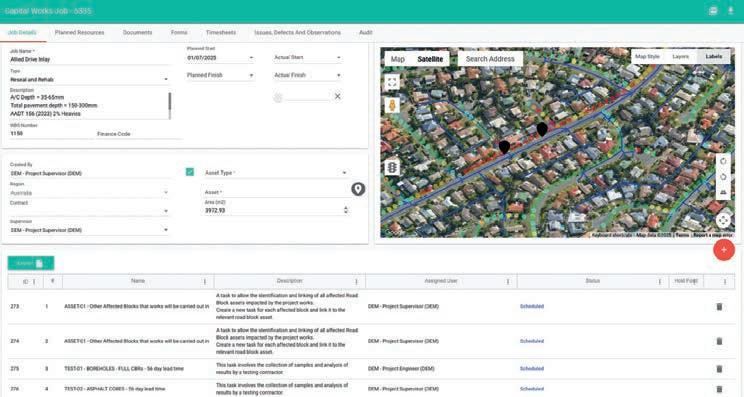
the very latest and best of the municipal works sector.
From technology, through to road maintenance, and larger-scale trade equipment, Converge’s dedicated municipality area will act as a one-stop-shop for council fleet managers and sub-contractors to see the latest tools on offer, with a special focus on zero-emission technology.
Chris Wignall, Head of Sales – Asset Vision, says the company is continuing to make waves in the municipality sector, with the company clearly identifying the space as a growth area.
“Within the past couple of years, we’ve really doubled down on making sure that what we offer is a complete solution for local government. We’ve invested heavily in research and development, hired new people, and more to make sure we’ve got a fully rounded solution,” he says.
“Many councils have ended up with three or four software subscriptions to do different jobs. Now they can look at Asset Vision and go ‘actually, we only need one solution, and the cost of that is less than the others’.”
Across transport, utilities, municipal works and construction, Asset Vision has developed a platform that’s designed to allow both the asset owner and the contractor to collaborate on the same platform.
All of this has been achieved by what is a local business, focused on working with local companies to best understand what’s required for Australian applications.
“We’re a 100 per cent Australian business. The development team is in Victoria. The support teams are co-located with the development team,” Wignall says. “We’re really proud of what we’ve been able to achieve so far with our local partners, such as Moyne Shire and the Greater Dandenong Council.

We’re also really excited about our expansion into Water Utilities and our latest client to come onboard in this sector is Western Port Water.”
And the company isn’t done just yet.
“The company is a part of me. It’s amazing to see how far it’s come and also what’s in front as we expand and round out our solution, particularly for councils,” Smith says. Come and see what Asset Vision has to offer at the 2025 Converge Expo. For more information on the highly anticipated show, visit: https://convergeexpo.com.au/ attendee-enquiries/
Left: Planning capital works using the built-in GIS (Geographic Information System), showing condition data and water mains.

PIPES APLENTY AT NODIG DOWN UNDER
THE 2025 EDITION OF NO-DIG DOWN UNDER IS SET TO RETURN THIS SEPTEMBER IN MELBOURNE. ROADS & INFRASTRUCTURE SHEDS SOME LIGHT ON WHAT ATTENDEES CAN EXPECT TO SEE.
No-Dig Down Under is the southern hemisphere’s only large-scale conference and exhibition dedicated to trenchless technology.
This year’s event will return to the Melbourne Convention and Exhibition Centre and take place from 17–18 September.
Organised in partnership with the Australasian Society for Trenchless Technology (ASTT), No-Dig Down Under has grown over the years to become the second largest no-dig technology event in the world and is now considered a mustattend for all industry professionals.
This year, No-Dig Down Under will feature an exciting technical program, inviting speakers from around Australia and the globe to present papers covering case studies, new and emerging technologies, challenging projects and environments, industry skills and training, risk management and more.
An extensive social program will also take place, including the much-anticipated ASTT Gala Dinner and Awards Evening, providing attendees with networking opportunities in a variety of settings. Bringing together leading decision makers, sub-contractors, project engineers, among other key people, the social program is the perfect platform for meeting industry leaders and developing knowledge.
One of this year’s first-time exhibitors is
Amiblu, a global leader in pipe technology. Amiblu Sales Director Chris Fraraccio says the company is proud to sponsor the event, especially after a transformative year.
“In 2024, Amiblu acquired RPC Pipe Systems, who was a licensee of the Flowtite CFW-GRP pipe technology. We’ve decided to exhibit at this conference to bring industry awareness to who Amiblu is in the market and our long-term goals – especially as the only Australian manufacturer of GRP (Glass Reinforced Plastic) jacking and relining pipe,” he says.
Fraraccio is a big fan of No-Dig Down Under, and said its value lies in its targeted focus on trenchless solutions, which opens the door for meaningful, technical conversations.
“We love that this event brings both suppliers and contractors together to discuss trenchless technology solutions –a targeted topic, which allows for more in-depth conversations,” he says.
Looking ahead to the 2025 edition, Fraraccio said the Amiblu team is excited to officially debut under its new name.
“We’re looking forward to being a firsttime exhibitor at No-Dig, presenting our new identity to the market,” he says.
Fraraccio adds that it’s an event not to be missed.
“If you are involved in civil infrastructure, you should be attending this conference,” he says. “The trenchless industry is a

growing market, and you may not know how trenchless solutions could cater for your construction needs.”
Amiblu also plans to make a splash on the exhibition floor with a strong focus on sustainability and product innovation.
“We are the technology owners of Flowtite continuous filament wound, HOBAS centrifugally cast, and NC line filament wound processes. These three unique manufacturing methods provide market insights to help attendees understand which product line is best suited for a trenchless project,” Fraraccio says.
“We’ll be showcasing our jacking, relining and non-circular product lines, with a focus on how our solutions contribute to reducing CO2 emissions from a product perspective.”
The Austrian-based Amiblu expanded its operations into Australia and New Zealand last year, by acquiring RPC Pipe Systems. Pipeline leaders will be in no shortage as attendees browse through the Convention Centre, with Interflow, Pipe Core, Australian Pipelining Supplies and RDO Equipment among the companies exhibiting.
Key utilities Greater Western Water, South East Water, Melbourne Water and Yarra Valley Water will all be in attendance too, with key representatives presenting their latest projects as part of the conference program.
For more information, visit nodigdownunder.com
This year, No-Dig Down Under will feature an exciting technical program.
CONTRACTS IN BRIEF
ROADS
& INFRASTRUCTURE PROVIDES AN UPDATE ON SOME OF THE CONTRACTS AND TENDERS RECENTLY AWARDED OR PUT TO MARKET ACROSS THE AUSTRALIAN INFRASTRUCTURE SECTOR.
NEW SOUTH WALES
Tender won for $100M road upgrade planning
A contract has been awarded for the assessment and development of strategic options for a $100 million upgrade to the Bells Line of Road in New South Wales. The Bells Line of Road (State Route 40) is an important road linking north-western Sydney with central and western New South Wales. The road is one of two road crossings of the Blue Mountains, the other being the Great Western Highway. Traffic numbers are increasing on the Bells Line of Road, with the connection also being heavily impacted by extreme weather from floods to fires in recent times. A range of improvements are being considered including new overtaking lanes, realigning curves, installing safety barriers and intersection upgrades. Transport for NSW will engage with local councils and other targeted stakeholders, with the wider community set to be consulted on a proposed list of additional works by the end of this year.
Contract awarded for works on $130M Avoca Drive project

A major contract has been awarded for the delivery of the concept design and environmental assessment for $130 million in upgrades to Avoca Drive, in New South Wales. AECOM has been awarded the contract to develop the aforementioned items for works that will take place on Avoca Drive between Boora Boora Road and Joalah Road at Kincumber. This will include identifying the priority first stage of the upgrade to be delivered. Avoca Drive is around 13 kilometres long and is a key east-west road on the New South Wales Central Coast. It provides critical links between the southern coastal suburbs, Terrigal Drive and to the M1 Motorway and rail line via the Central Coast Highway. Avoca Drive through the township of Kincumber is used by an average of about 26,000 vehicles a day, with heavy vehicles accounting for around six per cent of daily traffic. During peak travel, motorists experience congestion and slower travel times in the busy section. With increasing population and employment in the region, traffic volumes are predicted to increase over the next 30 years, leading to further reductions in traffic performance. This will help to improve safety, traffic flow and travel times for motorists to cater for existing and future traffic flows along Avoca Drive. The improvements will provide pedestrian and cyclist facilities and improvements to public transport access, helping to increase

multi-modal connectivity. When complete, the project will reduce congestion and create a safer road environment for all road users, including pedestrians and cyclists. The concept design and REF (Review of Environmental Factors) is expected to be displayed for community stakeholder feedback in 2026.
Contract signed for works on Western Sydney chokepoint
A contract has been awarded and finalised to upgrade connections between the M5 Motorway, Moorebank Avenue and the Hume Highway in Sydney. Seymour Whyte has signed the contract for works on the project, which include a new three lane toll-free bridge over the Georges River and train lines at Liverpool, improving the connections between the M5 Motorway, Moorebank Avenue and the Hume Highway. The upgrade includes the removal of the weave on the M5 Motorway between Moorebank Avenue and the Hume Highway to improve safety and traffic flow for road users entering and exiting the M5 Motorway. The project will also include a new underpass at Moorebank Avenue, connecting the M5 Motorway westbound to the Hume Highway, and upgrade the intersection between the M5 Motorway and Moorebank Avenue. The existing bridge over the Georges River, which connects the M5 Motorway to the Hume Highway and Moorebank Avenue, sees more than 2500 trucks a day move from the Moorebank Intermodal Terminal Precinct onto the Sydney motorway network. Afternoon peak sees traffic bank up, as cars and trucks entering the motorway westbound at Moorebank Avenue attempt to merge with traffic already on the motorway that is looking to exit at the Hume Highway. Truck numbers on the interchange are also expected to increase as new sections of the expansive Moorebank Intermodal Terminal Precinct come online. Both the Federal and New South Wales governments have each committed $190 million towards the project as part of an ongoing Western Sydney infrastructure blitz.
transport. The new Sydney Olympic Park metro station will deliver an integrated precinct and strategically important station on the Sydney Metro network, providing access to events, sport and entertainment. To provide increased capacity during events, the new metro station will feature platforms on both sides of the train, to support large crowds as they board and disembark simultaneously. Connections to other transport modes – including existing train and future light rail services – will further integrate the precinct into Sydney’s broader transport network. The shortlisted consortia includes FCC Construction Australia Pty Ltd and Ecove Group Pty Ltd (FCC and Ecove); Gamuda Engineering Pty Ltd, Gamuda (Australia) Pty Ltd and MTR Corporation (Australia) Pty Ltd (Gamuda and MTR); and John Holland Pty Ltd and Freecity Group Holdings Pty Ltd (John Holland and Freecity). The contract for these works is expected to be awarded in mid-2026.

VICTORIA Contract awarded for Melbourne road upgrade
Shortlist revealed for Sydney Metro station contract
Sydney Metro has shortlisted three consortia for works to deliver an integrated station and precinct development, which includes the design and construction of the new metro station at Sydney Olympic Park. The new Sydney Olympic Park metro station will support the transit of more than 10 million people annually, providing easy interchange with the planned Parramatta Light Rail, the T7 Olympic Park line, buses, as well as active

A contract has been awarded for works to upgrade the Thompsons Road and BerwickCranbourne Road intersection in Melbourne’s south east. Whelans Group Investments was the successful bidder for the project that will see the removal of the current roundabout and replace the intersection with traffic lights, and enhance bus infrastructure, improving driving conditions and motorists’ safety. The project will aim to cut congestion and improve traffic flow for the 47,000 motorists that use the intersection daily. Walking and cycling paths will be built along the intersection upgrade, offering safer travel options for all road users. Over the coming months, crews will undertake site investigations, utility relocation and site establishment works, paving the way for major construction to begin later in the year and to be completed in mid-2027. The project is in addition to already completed projects in Melbourne’s southeast, aimed at reducing congestion for one of the city’s fastest growing areas. These works include upgrades to Narre Warren-Cranbourne Road, Pound Road West and Healesville-Koo Wee Rup Road and Hall Road.





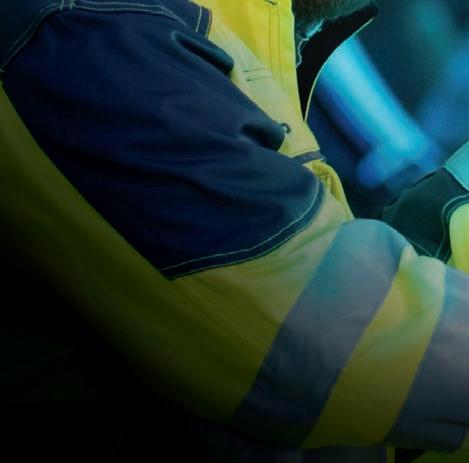
17–18 SEPTEMBER 2025 Melbourne Convention & Exhibition Centre Australia’s hub for civil, commercial, and municipal solutions


Converge Expo brings together industry leaders across the municipal, civil and commercial construction sectors who are change makers shaping Australia’s future infrastructure.
